#may the current day incarnations of the legacy he was a part of--
Text
My DC Cinematic Universe: Superman (Epilogue)
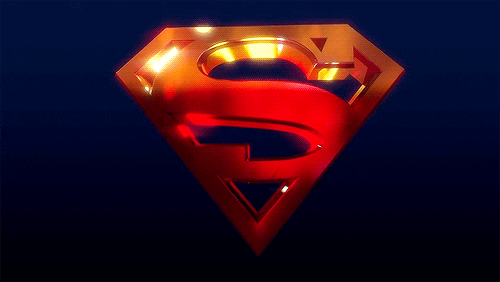
Epilogue: A New World
So, it's currently February 4, 2023 when I write this, and James Gunn officially announced part of his DC Studios plans a few days ago, on January 31. Included in these plans were two revelations. First of all, the first chapter of the new DCU is called "Gods and Monsters", presumably bringing in multiple projects that follow that theme. And frankly, I think that's pretty interested, but also.. conflicting for me for a couple of reasons. I dunno, it feels somewhat simplistic as things go, but that's not necessary a bad thing. Call it the cynic in me.
Secondly, though, is the announcement of the upcoming films Superman: Legacy and Supergirl: Woman of Tomorrow. And my thoughts on those are complicated, but interested. I have some trust for Gunn, but hopefully that doesn't degrade with these new projects. I'm gonna tackle the latter one first to say one thing:
Please, PLEASE read Tom King's Supergirl: Woman of Tomorrow.

This book is absolutely incredible. It's pretty obviously based on the book True Grit, which has had two film adaptations, and it pretty well-known. But King uses the concept behind the Western, sets it in space, and makes Supergirl into its Rooster Cogburn. Whether or not you like True Grit or Supergirl as a character, this story revitalized both effortlessly. It gives us a new view at Kara Zor-El, now 21 years old in the universe of the story, and also lets us see a whole new and truly gritty view of a backstory that, frankly, makes sense with every incarnation of the character. It's a brilliant dissection of the character, and the fact that it's being brought onto the big screen...this could be the Logan of DC films. Oh, and if you couldn't tell from the above art, it's absolutely gorgeous as well. Just trust me, you should read this book.
So, yeah, I'm real excited about that annoucement. Is it how I would introduce Supergirl personally? I mean...no, not really. She's a character that I think should be introduced elsewhere, then given this story as a series. Additionally, I think that a story like this would be an interesting way to introduce other elements of the DC Universe on a cinematic sense, while the book relies on very little knowledge of the DC Universe, except for some VERY specific references that kinda come out of nowhere in context with the modern DC Universe. That may be nitpicking, though. Lastly, while this is a great Supergirl story, I honestly think it would function better as a series than it does as a movie. Because, frankly, we already have a movie like this, and it's called True Grit. But don't get me wrong, I'm super excited to see what Gunn and company do with this story.
And then, on Superman: Legacy...I have...thoughts.
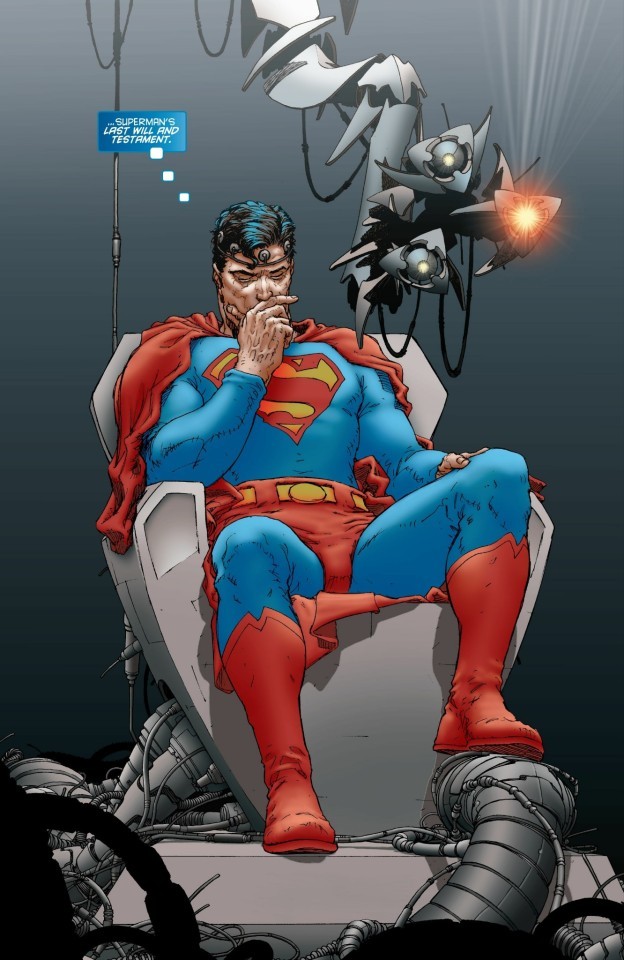
Hey Now...
OK, look, All-Star Superman is, without a doubt, one of the greatest Superman stories ever written. It's a written and drawn testimony to one of the greatest heroes that has ever lived, and acts as an epic of love, loss, and redemption for Superman and everyone around him. More than that, though, it's a reflection on the man himself, as well as his, at the time, 70-year history, and a love-letter by comic book historian and underrated wunderkind, Grant Morrison. They're a goddamn genius, and I hope you all know that! Read or listen to their book Supergods if you want a better view of the history of the superhero in DC and Marvel. It singlehandedly gave me a greater appreciation for both Morrison and comic books in general, AND SHOULD BE REQUIRED READING FOR ANY COMIC BOOK FAN!!!
So, that said, what is All-Star Superman about. Well, as that above image implies, it's revealed that Superman is dying of solar radiation, due to the machinations of Lex Luthor. So, in the process, and with the knowledge of his imminent death, Superman has more power than he's ever had before, and decides to use it to use his remaining time well. He tells Lois his secret identity, decides to try and permanently save the world, and finally deals with Lex Luthor in the most poetic possible way. I won't reveal the ending, but suffice to say, it's a perfect ending for this story, as well as being a true-blue ending. It's also an excellent reflection on both Clark and Luthor, as a decent story for Lois as well. So, it makes sense from a quality-based standpoint that Gunn is using this story as a basis...
...Right?
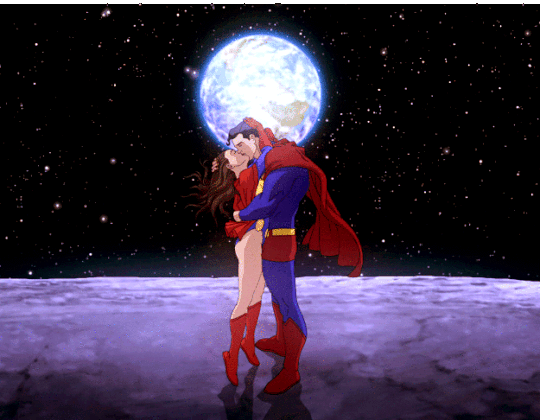
Look, I love All-Star Superman, genuinely. It's a beautiful story, and was also made into a great movie. Seriously, if you haven't seen the movie, check it out! It's on HBO Max, and it's a pretty close adaptation to the original, with some frames taken straight from the panels of the book. But it's also absolutely not a modern Superman story, in any way. All-Star is, if anything, a love story to a Superman long-since gone at the time it was written. Specifically, it's a story about the Silver Age Superman, as well as a love-letter to the time period.
As an example of this, this is a Superman with the ability to make tiny suns on an anvil, which is a comical amount of power. It's the kind of power that only a Silver Age Superman can have. It's also a Superman that's never told Lois who he is, which isn't a deal-breaker at all, but is representative of an older version of the character. Additionally, due to the events of the story, he actually becomes immune to Kryptonite. And in case you're wondering how the fuck that's even possible, the answer is simple. And, uh, spoilers ahead here, but...
Superman dies at the end.
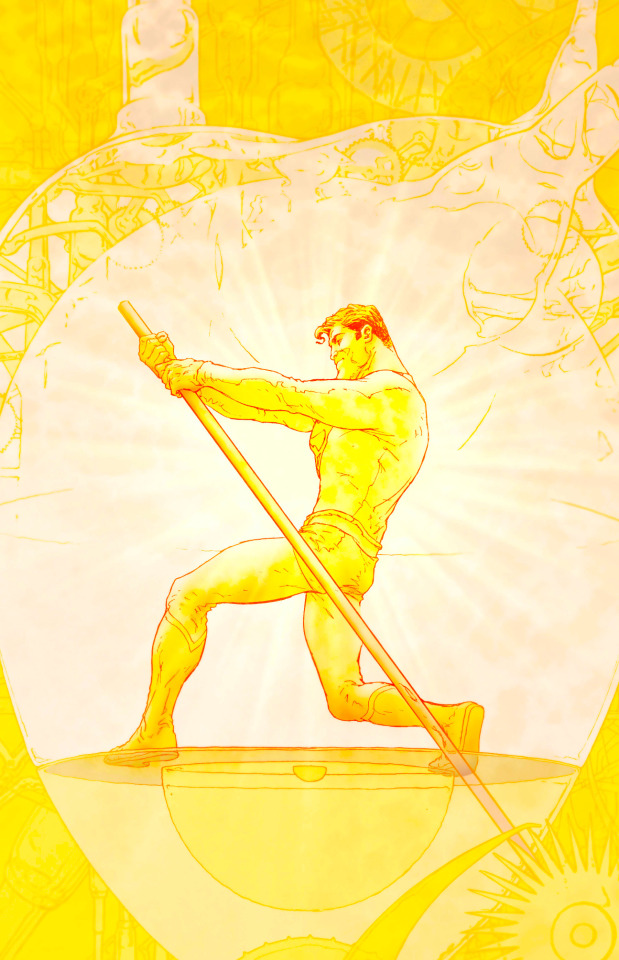
See why this is a weird choice for a Superman movie, especially the first story for a new version of Superman. All-Star Superman is, by it's very purpose, an ending to an insane story. Throughout this story, Superman is essentially exacting his last will and testament, and doing everything he can to end his life in an ideal way. And as such, it's also a love story to the character and all facets of his life. It's true that this story have given us some of the greatest Superman moments in any book, with the suicide prevention being one of the most famous of these. And yeah, it's a great take on the character in a lot of ways. But even then, it's simply not a Superman for a modern age. And that's not the only problem with using this story.
See, the villains are, as fucking always, Lex Luthor, a couple of Kryptonians very similar to Zod, and a crazy-ass cameo from Parasite. There are also some weird-ass side characters that are pure Grant Morrison, like the UltraSphinx and Quintum. It's either already been done, or it's just a weird choice to throw into a new version of Superman. It's a story that makes no sense as a beginning, for the most part. But, yeah, there are scenes like this.

Morrison's got a great grasp of the character, and they write a lovely book. But still, weird choice for an inspiration. That, of course, is assuming that Gunn follows this book to a T, which I personally doubt. I mean, Gunn is a smart man, and a good writer, not to mention probably aware of everything I've said. So why say that this is the story he's basing the film off of? I think the obvious answer is that this is one of the most recognizable stories (and covers) of any modern Superman story, and that (again) it has multiple moments that exemplify Superman. In fact, when you read Gunn's statements about Superman, it seems like he's mostly taking the innate goodness of the character, which we see in All-Star for sure.
And with that said, using the entire story makes even less sense when you consider the released description of Superman: Legacy.
Written by Gunn, the film will hit theaters on July 11, 2025, and focus on Superman balancing his Kryptonian heritage with his human upbringing.
Y'know what classic-but-underrated book that actually sounds like?

Lemme tell ya, I adore Superman for All Seasons, and it isn't really a forgotten story...but I feel like it tends to slip under the radar as a great Superman story. That may because it doesn't have any massive stakes, or world-ending threats. It's a down-to-Earth story about a down-to-Earth guy trying to do good. Each chapter is told from a different supporting character's perspective, all about the Kansas boy turned local hero. And through it all is a story of Clark Kent trying to figure out what the right thing really is.
This is one of my favorite Superman stories, and the tone for this book is what I took my tone for my story from. Granted, I added some big stakes to that, but the character of Clark Kent himself is based on the kind person seen in this story. It's not necessarily a book that I think everyone loves, but it's absolutely one of my personal favorites. Check it out if you want some perspective into my ideal Superman.
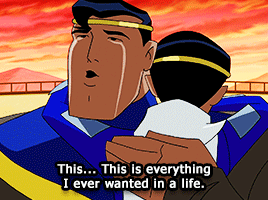
Look, Superman is hard. I get that. He's a difficult character to nail, and most people don't really get the character. But there are some amazing stories by writers who really understand the character. Grant Morrison's grasp on the character mostly veers into the Silver Age incarnations, but he still gives a more modern version of the character some great moments. Alan Moore REALLY gets Superman, and his Silver Age homage Whatever Happened to the Man of Tomorrow? is another underappreciated classic story, while For the Man Who Has Everything is one of the best comic book stories ever written. It also has the benefit of showing just how tragic the Superman story really is, and was turned into a brilliant episode of Justice League Unlimited (which is the only adaptation of his work that Moore actually likes).
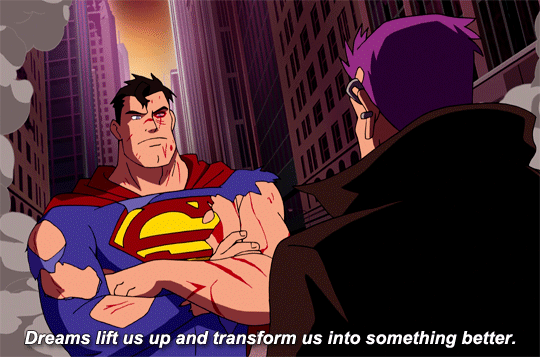
There is, of course, the timeless What's so Funny About Truth, Justice, and the American Way?, written by Joe Kelly, and is another iconic one-issue story. Turned into the equally excellent movie Superman vs. the Elite, it's a great treatise on the seemingly black-and-white morality of Superman in a greyscale world, while also revealing that his methods are actually far more complex than they first appear to be, using Manchester Black as the opposing force. It also manages to humanize Superman without putting him onto a moral high ground in a condescending way.
Superman: Grounded, while being a somewhat controversial arc in Superman's story, is one of the best recent stories about the character, literally bringing him down to Earth. Not universally amazing, but it has some fantastic character moments for the Man of Steel. And, uh, speaking on controversial, The Death of Superman story actually has some amazing moments for the character, but is honestly a great story for his supporting cast, and lets us see the Man of Steel through the people who did and didn't know him best.
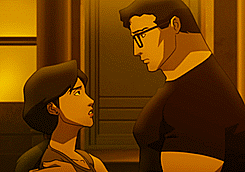
For a great Golden Age Superman story, as well as a story about a young Superman, check out Superman Smashes the Klan (which is inspired by a true story, fun fact). That's also an example of a Clark Kent-biased Superman that I absolutely adore, but it's also an amazing story about being an outsider in general. Genuinely one of the best comic book stories I have read in a while.
And there are many others, of course. Hell, the 2016 Superman run was pretty great until Bendis aged up Superboy. But that's an anger-filled rant for another day, I think. Fact of the matter is, there's a lot of Superman material out there that's great, and I always feel burned that people think he's a boring, over-powered lout of a character with nothing interesting about him. Especially as compared to...some.
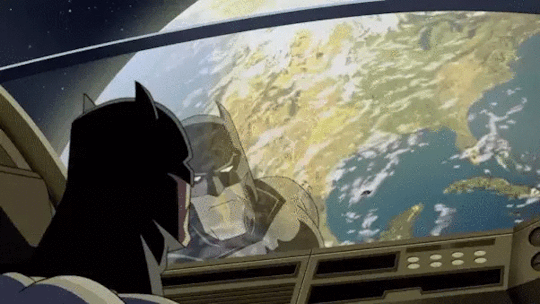
I won't go into another rant about it, but Superman deserves a lot more attention than he gets. His stories, his humanity, his very essence...they get overlooked and ignored in favor of characters seen as more interesting because they have a tragic past, which somehow makes them relatable. But Clark Kent is, in all ways except for physical, a wolf human. And thinking of him as such is what gives us some of his best stories. I like All-Star Superman as much as the rest of us, but it REALLY doesn't do that very well. It does it, don't get me wrong, but not very well. By focusing on a Superman of a different time, rather than Clark Kent of today, it gives us a purely good, but also alien, Superman. I trust Gunn...but All-Star Superman, to me, is not a complete Superman. So, for now, I'll just have to pull a Clark Kent and...well...hope.
And with that...well, I think the time has come to put Superman away on the shelf. And turn my gaze from the daylights of Metropolis...to the nights of Gotham City.
What the hell am I getting myself into?

Next: My Cinematic Universe: Batman (Coming Soon)
#superman#clark kent#all-star superman#superman for all seasons#grant morrison#frank quitely#jeph loeb#tim sale#dcu#dc movies#james gunn#dc cinematic universe#my dc cinematic universe#dccu#film ideas#my film ideas#dc comics#dc fanfiction#dc headcanon#dc
4 notes
·
View notes
Text
Todoroki Enji and the Egyptian Sun God Ra
(Part Four: Mythological Influences in Boku no Hero Academia)
Note: ok, so I’m kinda nervous to post this. . . but here we are

So how did I get to comparing the Egyptian sun god Ra to Endeavor? To sum it up, this is the fourth post in a set of analysis and meta about mythological influences in BNHA, so a lot of this builds on top of the info and connections I’ve made previously.
There are quite a few references and influences to Greek mythology in BNHA and personally I was very intrigued with the Hawks and Icarus parallels that kept popping up. In the myth of Icarus, the sun melts the wax off of Icarus’ artificial wings which causes him to fall and drown in the ocean. I saw Endeavor as one of Hawks’ metaphorical “suns”. While I sat on that, I began looking at Tokoyami, since he has a mentor-student relationship with Hawks, and found how he has Egyptian influences in his character design which I wrote about in a post here.
I began researching and reading through ancient Egyptian myths and information. One of the figures that caught my attention was the ancient Egyptian’s most important god: Ra, the sun god. (He is the falcon headed figure depicted below.) I quickly found some similarities between Ra and Endeavor.

This image is from the expereince-ancient-egypt website.
Before I begin, I’d like to say I am very much aware that BNHA is a Japanese manga series and that the story is greatly influenced by Japanese culture and society. Unless there are very explicit examples (such as the case of Tokoyami) this post is not me saying that Horikoshi intentionally wrote certain characters and aspects inspired by Egyptian mythology. I just like like finding interesting similarities whether they were intentional or coincidental and writing about it.
That being stated, let’s begin.
Ra: The Egyptian God of the Sun

The original source of the image above is unknown.
So, who exactly is Ra?
Ra was the Ancient Egyptian sun god. The sun had a special place among the ancient Egyptians, they considered it the source of life. He was... the creator of the universe, one of the most famous deities...
Ancient Egyptians believed that Ra created himself, and his tears created humans. The setting of the sun means the beginning of the daily journey by Ra, in which he travels by his holy boat to the underworld every evening, to fight the forces of evil represented in a big snake called Apophis, and then returns to a brilliant triumph in the heights of the sky every morning on a new day. The ancient Egyptian saw this as a sign of human resurrection, and also evidence of Ra’s victory over the forces of chaos and evil (cleopatraegypttours).
Throughout all the websites I went through, Ra was very closely associated with the themes of the sun, life, the underworld, resurrection and victory over chaos and evil.
Let’s focus more on Ra’s journey through the underworld.
During his life he was required, as the incarnation and representative of the sun god, to maintain the cosmic and social order (ma’at) established by the god of creation. He had to repel the forces of chaos which constantly threatened the order of the world.
After his d/eath, the king united with the sun disk and his divine body merged with his creator. In his new role he continued to perform the task of subduing the powers of chaos. This active role of the king and sun god necessitated a detailed description of the d/amned, who represent the forces of evil.
Perhaps you may be starting to see the similarities and connections I began to form between Ra and Endeavor. If not, it’s okay. Sometimes II have to sit on a lot of the information I’m taking in before I see anything.
Endeavor’s Powers
Endeavor’s fire-based quirk is called “Hellflame.” The list of his named moves are: Flashfire Fist (Jet Burn, Hell Spider, Hell’s Curtain), Karmic Raze - Hellfire Storm, Raging Assault - Hell Minefield, Vanishing Fist, and Prominence Burn. As you can see, there’s a lot of mentions of the word: Hell.
While we can connect the “hell theme” back to Ra’s connections to the underworld, I would first like to point out what the Egyptian underworld was. We associate fire, suffering and other things with hell, however, this is a depiction that comes from the Abrahamic/Judeo-Christian religions.

The image above depicts a section of the Egyptian Book of the D/ead with Osiris on the left and the Weighting of the Heart taking place on the right.
There were many sources that described the extensive processes of the underworld and afterlife so I’m keeping it simple here. Anyways, the ancient Egyptians did not really have a concept of this sort of hell. Instead, after death, a part of the soul would travel through the underworld which was also known as Duat for judgement. They underwent a judgement process that had two parts and if they passed, they moved on to the Reed Fields which was Paradise. Those who failed simply ceased to be.
The “hell” that is probably being referred back to with Endeavor’s quirk and powers most likely was influenced with other cultures, again more specifically those with Abrahamic/Judeo-Christian religions. Despite this difference I do still think that there are other interesting similarities between Endeavor and Ra.
For example, I’ve already established in a previous post that I like to associate Endeavor to the sun. A lot of this post will rely heavily on what happened during the High End vs Endeavor fight. The move he is using above is called “Prominence Burn.” According to NASA:
a solar prominence (also known as a filament when viewed against the solar disk) is a large, bright feature extending outwards into the Sun’s hot outer atmosphere
This is the finishing move that helps Endeavor defeat the High End and this is very significant because it is the only move with a name that relates back to the sun.
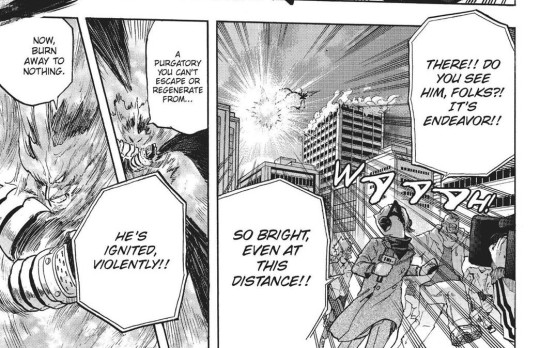
In Chapter 188 during the High End fight, Endeavor is even depicted as a fiery sphere of fire and light high up in the sky, very visually similar to the sun.

If you need more evidence for sun related themes surrounding Endeavor, Ending, the criminal who kidnaps Natsuo describes him as “A fierce solar flare that shines bright.”
One of Ra’s main duties is to keep order and defeat the “forces of chaos and evil.” Endeavor and the heroes in general sort of view themselves as this force of good and see the “villains” as enemies that have to be taken care of. I don’t agree with the ideas that “all heroes are good, and all villains are bad” and that is definitely not the message that Horikoshi is trying to send. It is because that sort of belief exists that hero society is flawed. Typically, when reading through mythology or religious texts, the themes of absolute good and absolute evil are common. Those are the contexts in which gods and other figures that exist. Humans are flawed and tend to stand somewhere in the in between.
That being stated, Ra and Endeavor are similar in their ties to the sun, underworld and sense of duty that they must defeat the “forces of chaos and evil” for the sake of everyone else.
High End vs Endeavor
Endeavor greatest ambition in life was to become the number one hero. He may act like a hero in the public’s eye but he does not have a “heroic nature” or “character.” He failed and broke his own family for the sake of his ambitions, and arguably, the Todoroki family came in to existence to serve a certain purpose. If he could not become the number one, then he’d make sure that someone with his blood and name would achieve that one day. However the unexpected happened. All Might had to retire and Endeavor was given the title as number one hero. He didn’t earn it. He was given it purely because he was the number two hero.
Let’s revisit the High End fight. This conflict happens shortly after the Hero Billboard Chart event. Japan is uneasy as their symbol of peace has retired and they do not know whether they can rely on the new number one hero. His family also is conflicted with his new position and how it was given to him. Throughout the fight we take a step in to Endeavor’s thoughts and inner monologue.
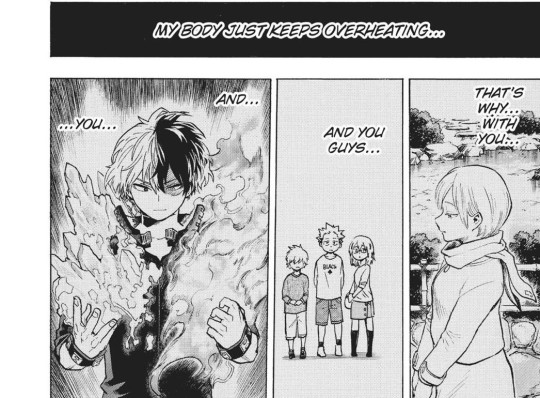
The manga panel above is from Chapter 188.
The High End is incredibly powerful and even with his powerful Hellflame quirk, Endeavor is having a hard time fighting against it. One of the weaknesses with having a fire related quirk is that it overheats his body so he’s had to rely on using his flames properly and cooling down afterwards. Because of this, he thinks about his family. The family that began because of this very weakness. His memory goes back to Rei when she is young, perhaps at the beginning of their arranged marriage or shortly before. Touya, Natsuo and Fuyumi are young as well. Standing far away and unhappy, maybe even nervous. And lastly, Shouto, the child he wanted to continue his legacy in, activating both his ice and hellflame quirks. He is the only one depicted in his actual current age.
On top of the very next page we get a scene with the High End Nomu speaking as seen below.
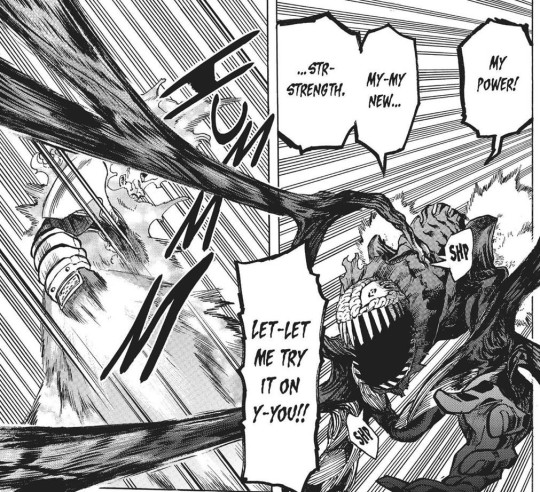
This Nomu came to fight and defeat whoever was the strongest. Despite it’s ability to speak, it is still mindless, declaring on and on about its power and strength. It does not care about who it is fighting and the destruction that is occuring along the way. The High End has multiple quirks that were chosen specifically to make it as powerful as it could be. Perhaps it was in this moment that something clicked in Endeavor’s mind.
Soon after, the High End strikes Endeavor multiple times, with one strike later leaving him with the scar that runs down the left side of his face. He falls to the ground and in to the rubble. Chapter 188 ends on this page with the manga panel seen below and everyone is left to wonder whether Endeavor is dead or alive.
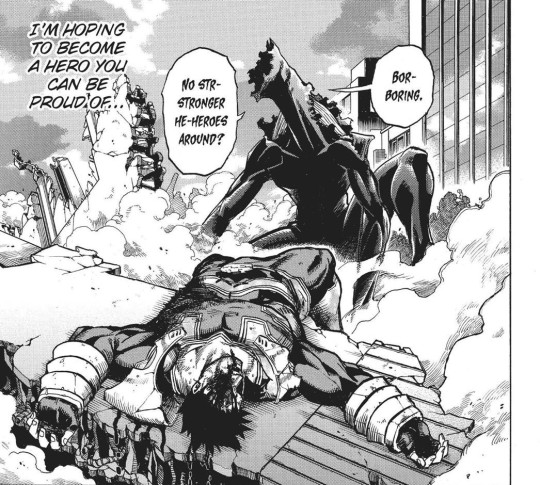
In Chapter 189 we see the effects of the void All Might left due to his retirement.
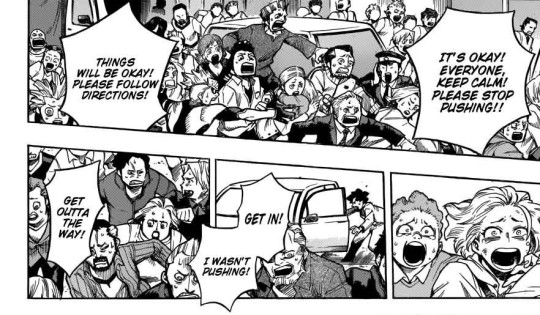
If the “villains” can’t be kept in check the public becomes chaotic with fear. A quiet night fell over Japan after All Might retired. People felt like the light was taken away. Then Endeavor gets up. With Hawks’ help he rises in to the air with wings on fire.
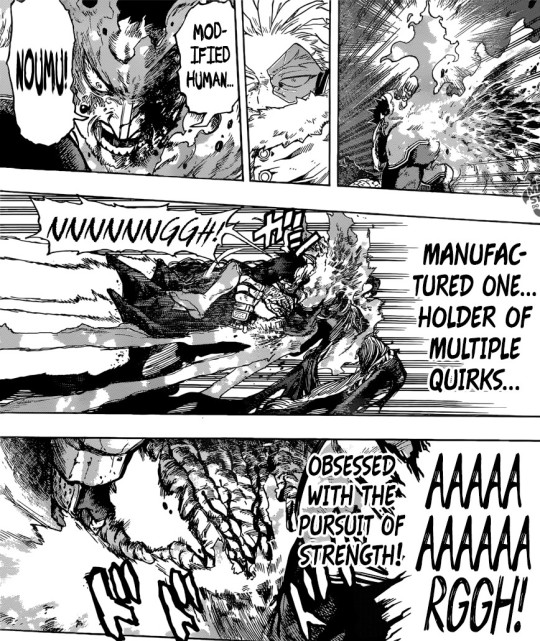
And in Chapter 190 he defeats the High End Nomu with Prominence Burn.

Endeavor and the Dawning Sun
There’s a lot of things going on here. Endeavor basically follows the journey Ra takes every single day to complete his duty. Similar to how Ra “dies” as he travels through the underworld, at one point we are led to believe that Endeavor has been killed by. As most of the battle took place up in the air, Endeavor physically falls when he “dies.” Leading up to the fall, he is thinking about his family and the past.
While Ra and Endeavor “resurrect” at different points in their journey, they both rise back again in order to fulfill their duty to bring back “order and balance.”
I’ve already written about the falcon/hawk headed Egyptian god Horus and Hawks, however I have yet to address the relationship between Ra and Horus. At some point, Ra was combined with Horus and became known as Ra-Horakhty which means “Ra, Horus of the Horizon.” Ra-Horakhty is most often thought of as the god of the rising sun. It is in this form that Ra rises in the sky to bring the dawn when he arises from the underworld.

The original source of this image is unknown.
There is a deity (seen above) that appears a lot throughout architecture from ancient Egypt called “Horus-Behdity” who is depicted as a winged sun disc:
The winged sun disc is highly symbolic representing the Union of Horus the falcon God, and Ra the sun god, the union of the Two-Lands of Egypt, and becomes a symbol of rebirth for the kings (British Museum).

Although it is Endeavor who ultimately defeats the High End, it is with the aid of Hawks’ quirk that he is able to land the finishing blow. He rises in to the sky like the winged sun disc: Endeavor as the sun, and Hawks as the wings. I think the depiction of Hawks with his back towards he audience and Endeavor burning them with his flames on the cover of Volume 21 says a lot of things (including the Icarus parallels!).
Taking a couple steps back, the wording on the pages where Endeavor addresses the nomu and then before uses the finishing move Prominence Burn on the High End is important.
“Modified human... Noumu! Manufactured one. . . Holder of multiple quirks. . . Obesessed with the pursuit of strength!” (Chapter 190)
“You are... Just like me! From the past, or perhaps from an alternate future. Now burn, and rest for all eternity!” (Chapter 190)
Endeavor is a controversial character that because of his past and the horrible things he did to his family. However, we can not ignore what has been written in the manga. I’m not going to argue or talk too much about my own thoughts and opinions here, but I think it is important to address what happened during this High End fight.
He identifies himself with the Nomu: the power hungry and mindless creature. It’s interesting that he uses the phrases of “manufactured” and “holder of multiple quirks,” and “pursuit of strength” which are words that are heavy with meaning to him: the arranged marriage he purchased, the children he neglected and the “perfect” child he sought after for the sake of strength.
The train of thoughts that had begun in his mind is expressed outwards. He shouts them out in to the sky. He acknowledges the past (however to what extent is debatable), and even addresses the future. I’m not sure if he’s acknowledging that he may fail to change or that he hopes that he can change what he can.
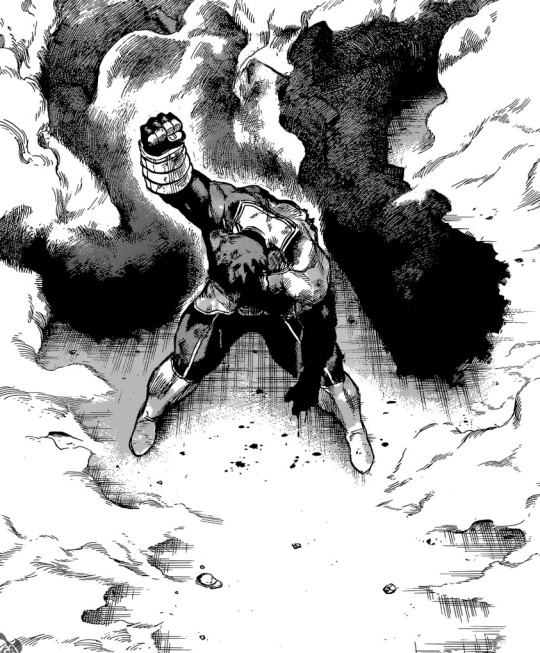
He then defeats the High End. Endeavor had been given the number on hero position but this victory is what “establishes” him with the title in the eyes of the public. With the bright light of All Might gone, the public is inspired by a new light, the sun that Endeavor represents bringing a dawn to the night. His victory pose is reminiscent of All Might’s however it is with his other arm that is in the air, he’s slumped over and his legs are barely keeping him up. The flames that usually cover his face and body are gone as well. This is the victory of Endeavor the hero but it could also be Todoroki Enji as a father making a statement.
I’m not sure if this is him symbolically k/illing the monster he was, or if this is symbolic as to where Endeavor’s journey will ultimately head towards, or if its a representation of hopes that never come true later on. I’m not trying to paint this piece from a pro-Endeavor stance or an anti-Endeavor stance but merely trying to explain how I interpreted the events of the High End fight and the thematic meanings it had as it unfolded. At the end of the day, we all have different opinions and interpretations and you have all the right to disagree with everything I’m writing in this post.
(The case with Endeavor is very complicated and I don’t want to get to deep in to it here however) We definitely should not forget what Endeavor did in the past but at the same time we should not ignore the efforts and progress he has tried to make. While we must hold people accountable for their actions, it is not wrong for someone to want to change or become better. Endeavor may “fail” or he may be able to “succeed,” whatever either entails or looks like. However even though we do get the depiction of a rising sun, you have to remember that the sun also sets.
Anyways, what has been established was that this fight is where Endeavor explicitly expressed his acknowledgement of the past (maybe not in its entirety but it is a big first step). And it is directly after this step that we take a deep dive in to what facing the past will look like for Endeavor.
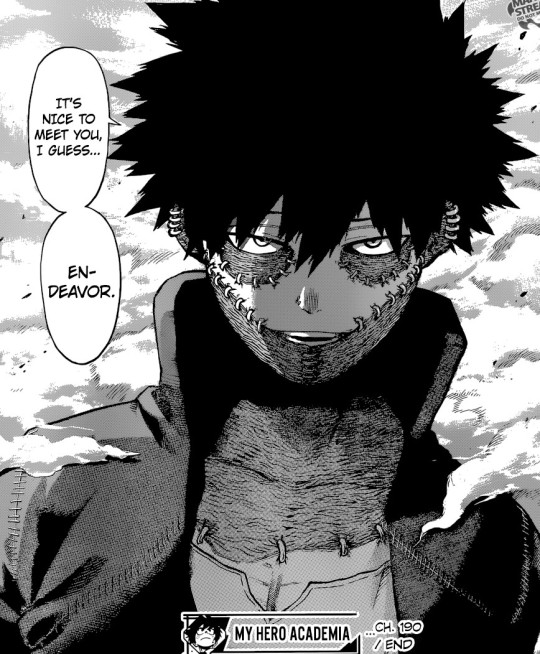
#endeavor#todoroki enji#hawks#takami keigo#bnha analysis#mha analysis#mythological influences#bnha meta#mha meta#dabi#todoroki touya#todoroki family#todoroki shouto#luna writes#my post
59 notes
·
View notes
Text
Kisekae Insights #18: Madoka Magica Part 1 (Takumi Magica)

(Art by dai)
The anime series that have had prominence in my personal project are at least ten years old now and this one is no exception as Puella Magi Madoka Magica celebrates its tenth anniversary in 2021. In fact, this post has been timed to be released ten years after the finale originally premiered (following a delay as a result of the 2011 earthquake).
This instalment highlights a complication associated with adapting series that are ongoing; some elements are implemented with the knowledge that something is the case, but then new material for the series comes out and it turns out that that thing is not the case anymore. Also, I do some male-centric gender equality because men are hated in current year thanks to SJWs and anime is sexist due to its constant focus on females.
How the involvement started
Madoka Magica was introduced to the project in 2012. In the mainstream series, they were introduced in the Series 7 Salacian Time War arc with seemingly no context, but they had a two-parter introduction in a spinoff series featuring the Fourth Doctor. I didn’t write the episodes, but I did use the titles in a couple fanfictions, titled Grief and Souls and The Girl Who Lives Forever, which showed my “interpretation” of the episodes, which was essentially the Doctor being involved in the plot of Madoka Magica. Looking back, it was a bit cringey and I’ll admit, I never watched the series in its entirety more than a few times, so my understanding of the series wasn’t as deep.
Much of the details I provide here may not match my initial visions back in 2012, not that it matters in the context of this series. On top of that, the ongoing state of the series has led to changes in the status quo, as this instalment details.
For the purposes of this project, Mitakihara is located northwest of Cardiff, past the Brecon Beacons along the A470 road.
Takumi Kamijō: The Magical Boy

Events here take place following the end of the TV anime. When the Salacian Time War happened, Parker enlisted Homura, Mami and Kyōko to be part of his army of 72. At the same time, Hiroki was kidnapped by Akari’s cousin, Daniel, and taken to his base in the Serra do Mar mountain range where he was subjected to the Dehydrator. Takumi was born from Hiroki’s sixth incarnation as a result of the ensuing meta-crisis regeneration. This left Hiroki requiring help to regenerate fully, resulting in Takumi’s “twin”, Kumiko, being born some time after.
It should be noted that at this point in time, Takumi appeared similar to Hiroki with black hair and he didn’t have a name yet. Also, due to the nature of Kumiko’s birth, Takumi would refer to Hiroki and Akari as his parents even though he would be considered Hiroki’s “sibling”.
After finding some clothes to wear, Takumi leaves the base and walks through the mountains to Santos, where he joins the battle against the Salacians at its climax. Following the battle’s end, Takumi makes his way to the Doctor and Parker, who entrust him to Kyōko and give him the task of working together with the magical girls to defend Mitakihara. At this point, Takumi moves on to his own spinoff series, aptly named Puella Magi Takumi Magica.
Upon arriving at Kyōko’s hotel room, Takumi sees her feeling sad and gets her to open up to him (somehow). It is then that he learns about Sayaka and her sad story, at which point he decides to “evolve” himself into a “reincarnation” of her by using the 15 hours of residual regeneration energy to turn his hair and eyes blue. Seeing his new appearance and likening it to the sea, he decides to give himself the name Takumi, though Kyōko states that while he may look like Sayaka, he will never be her, a fact which Takumi acknowledges.
Some time after, while exploring Mitakihara on his own at night, he encounters Kyōsuke Kamijō and Hitomi Shizuki, the two people who made Sayaka heartbroken. Following them to an alley, Takumi finds a metal pipe and beats the two of them up as revenge for Sayaka. He also decides to torture Hitomi by beating Kyōsuke up even more. They are only saved from certain death when Homura, Mami and Kyōko see the scene and pull Takumi away. This event leads Hitomi to make a contract with Kyubey and become a magical girl, wishing for the strength to fight back against Takumi.
After witnessing Homura, Mami and Kyōko fighting wraiths in the city, Takumi becomes determined to become a magical girl, or rather, boy, so that he can work together with them to defend Mitakihara like the Doctor asked him to. Though they initially laugh it off, the girls take Takumi to see Kyubey, but he refuses to make a contract with him because he is not a girl. After Takumi breaks the necks of a thousand Kyubey clones, he relents and allows Takumi to make a contract with him out of interest to see what would happen. Takumi wishes to honour Sayaka’s legacy by fighting in her place and as such, he gains powers similar to that of Sayaka’s. Unbeknownst to Kyubey at the time, fulfilling Takumi’s wish would be his undoing.
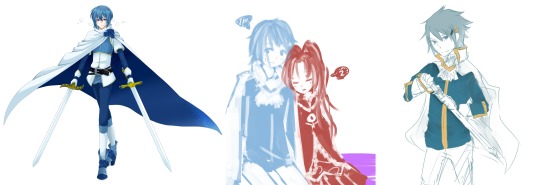
(These are just my impressions of what Takumi’s magical boy form would look like. Art by モリコ/とーま, purincipium/flaon and gureipu)
This ends the first major arc of the spinoff. Moving into the second major arc, Takumi learns that there are magical girls scattered all over Mitakihara and the world and makes it his mission to unite them as one. As such, Homura, Mami and Kyōko become the first members of Takumi’s team. Learning about how the Soul Gems and Grief Seeds work, Takumi uses this information (and latent Time Lord knowledge, yada yada yada) to invent the Incubation Cleanser, which would automatically purify any Soul Gems put inside it so that magical girls can fight without fear of falling into despair and disappearing/becoming witches. Think of it like in Rick and Morty when Zeep created the Miniverse as a replacement for the Gooble Boxes.
Hitomi, now a magical girl, finds Takumi and fights him as revenge for attacking her and Kyōsuke. After a couple of skirmishes, Hitomi decides to challenge Takumi to a battle – if he wins, she will join his team, but if she wins, she gets to take Takumi’s life. Takumi comes out victorious in the challenge and Hitomi joins his team, with Takumi forcing Kyōsuke to become a magical boy as security to ensure Hitomi’s loyalty. It is also at this point that Takumi takes on the surname Kamijō.
Takumi leads his team to Asunaro City in an attempt to recruit more magical girls for his team, despite being warned that they would be stepping onto the territory of other magical girls in the process. After some conflict, Takumi would gain the cooperation of Kazumi and the Pleiades Saints. He then found a place to establish a base for him and his group, which he names Torchwood Pleiades in honour of the two groups.
This is all that I have written for the series’ setting. Only two seasons of the spinoff were broadcast in 2012-13; the developments that follow are post-spinoff. During the course of the spinoff, Takumi and Kyōko’s relationship develops, but their resolution would be revealed in the mainstream Doctor Who series. Due to various factors, Kazumi Subaru, Kaoru Maki and Umika Misaki would be the only surviving members of the Pleiades Saints by the end of the spinoff.
The Rebellion Incident
Takumi’s character was created in 2012 during the development of the three Madoka Magica films. Learning that Sayaka would be revived in The Rebellion Story raised a conflict between her and Takumi, given that the latter was created as a replacement character for the former. As a result, Takumi did not have any involvement for most of my 2014 stories, mostly because I didn’t know what to do with them. I later figured out a solution and planned to write a special for Takumi Magica titled Afterrebellion, but I never got past the first chapter. What I’m about to tell you know is an impression of what that story would be like.
During the 50th Anniversary Series in 2013, Takumi and Torchwood Pleiades would have significant involvement in the stories. Takumi gained a sonic modulator from one of the enemies of the series and modified it for his own use. In the sixth block, the spirit of Sayaka transforms Takumi into herself for some temporary bullshit I didn’t write. In the ninth block, Takumi reveals that he is aware about the upcoming events when he says that there is a worse day coming for him, much worse than Hiroki’s death or Koshi Castle. Takumi and Kyōko get engaged at some point, but Takumi delayed their marriage in order to deal with the oncoming issue.
Around the events of The Rebellion Story, Kyubey came to regret making Takumi a magical boy because his actions subverted everything he was working for. He exiled Takumi to a pocket dimension, which he later came out of somehow. When Takumi came back, he saw Sayaka and quickly realised that he would lose everything, even Kyōko, if he allowed her to live as she was; after all, his main purpose for the past couple of years was to take her place and he couldn’t be left with nothing after everything he had done. Takumi proceeded to quickly confront Sayaka and absorb her into himself.
What follows is a fight between Takumi and Sayaka; since Takumi wouldn’t allow Sayaka to leave his body, she decides to fight him for control of his body. It was easy for Takumi to conceal the fact that he was having an internal conflict in public; since his face and hair wouldn’t necessarily be that different, he just had to wear a big-ass coat or something that wouldn’t show Sayaka’s breasts popping out every time she managed to gain control of his body.
Despite Takumi’s best efforts however, all is unravelled one night when Kyōko tries to have sex with Takumi. Kyōko discovers what is going on and after Takumi and Sayaka explain themselves, Kyōko gets them to find a way to cooperate. Eventually, the two distinct individuals become in sync with each other, allowing Sayaka to take control of or split from Takumi’s body. Takumi and Sayaka would later experiment having sex with themselves and having a threesome with Kyōko.
By the end of 2014, Takumi and Kyōko got married. This plot point wasn’t mentioned at the time, but in a way, Sayaka and Kyōko got married as well thanks to it. It’s honestly astonishing how much fanart I see of male Kyōko with female Sayaka but not male Sayaka with female Kyōko. I honestly think it would have been easier for Takumi to be in Kyōko’s place, but she’s not the dead girl at the start, Sayaka was.
Anyway, following the events of The Rebellion Story, which was nicknamed “the Rebellion incident” by Takumi, Homura exiled herself from Torchwood Pleiades in order to fulfill her role as the devil of the new world. Thanks to whatever Homura did (I didn’t watch the movie, I only relied on wiki info lel), the Incubation Cleanser was made redundant, but witches, wraiths and magical girls still existed and therefore, so was Torchwood Pleiades. Takumi reformed his team, with the exception of the Pleiades Saints, and somehow recruited Madoka to replace Homura’s place, giving her what was necessary for her to be a productive member of the team.
The Next Evolution
Alongside the Shinkengers, the Magirangers were one of the first teams to join UNIT’s Superhero Project during its beta testing stage in 2014, with two more magical girls joining them in 2018:
MagiRed: Kyōko Sakura
MagiYellow: Mami Tomoe
MagiBlue: Takumi Kamijō
MagiPink: Madoka Kaname
MagiGreen: Hitomi Shizuki
MagiShine: Kyōsuke Kamijō
Wolzard (Fire): Homura Akemi
MagiIce (Mother): Nagisa Momoe
While developing the equipment, Takumi accidentally created an extra MagiPhone because he forgot about Homura’s situation. He attempted to seek one of the remaining Pleiades Saints to give it to, but he was attacked by Homura, who stole the spare MagiPhone and used it to transform into Wolzard.
In one of the Superhero Project preludes, the Magirangers and Shinkengers worked together to defeat Hiroki and Narutaki, who had been turned into Grim Reaper vessels by Evil Death.
The Magirangers’ main feature in Gokaiger would be in the second episode, which follows the storyline of the third episode of the original Gokaiger. After the Gokaigers were separated by Salamandam’s volcanic blast, Takumi would test the Doctor and Marco to see if they were worthy of using the Magirangers’ Megazord Powers. Kyōsuke would give Kai a test as well by having him fight Wolzard, who defeats him in a Megazord battle.
The second part of the episode features Homura attacking the Gokaigers, Magirangers and Dekarangers as Wolzard with her Nightmares and Homulilly minions. Once the Magirangers and Dekarangers defeat Homura’s minions, the Gokaigers morph into the Dekarangers to finish off Wolzard. After the Gokaigers defeat the Centaurus Wolf Megazord, Homura fights them as Homulilly, only to be defeated by the Legendary Patrol Megazord. Following the battle, Takumi is insistent on having Homura rejoin Torchwood Pleiades, but Sayaka says that they “don’t need a demon like her”.
Later on, Homura fights alongside Takumi and her former friends in the crossover special when the Rangers and Riders are turned against each other. She would appear again in the series finale alongside Nagisa when they fight Prince Vekar’s invasion fleet with the other Rangers.
In the third Space Squad movie, Rassilon would accuse Takumi and his brothers of being homophobic due to them “taking” their girls away from their true (lesbian) lovers. Sayaka doesn’t blame Takumi for doing what he did; in fact, she is grateful to him for keeping her legacy alive when she wasn’t and now, she only wants to make sure that everyone can be happy.
Before I can continue with Takumi’s story, I will need to cover another story first, which is the story of the other magical boy, Yuki Yamaki. Once again, I’d like to remind everyone that Takumi’s backstory was retroactively written following his introduction because of the way I liked to write stories back then. See you in the next instalment for the continuation of this saga.
5 notes
·
View notes
Note
HC's for bakugou, lida, midoriya, and todoroki with an American S/O celebrating thanksgiving and teaching them about it??
For clarity’s sake: Thanksgiving has roots in the celebration of genocide and colonialism but Fuck Christopher Columbus i will Feast and then Vomit on his “Legacy”
Bakugou Katsuki:
-At first he thinks it’s ridiculously cheesy, but he can’t say you’re not cute flitting around the kitchen .-He’s forced into helping, his chopping skills are an invaluable and necessary force for the big day.-It’s just you two, you didn’t buy much and wanted to spend your first thanksgiving with your boyfriend alone.-He didn’t really want to invite his parents anyway, seeing him be all mushy with you as you fed him little tastes of things throughout the cooking process.-Half the things end up with a spicy touch of chili oil and red pepper flakes.-He finds out he LOVES mulled wine. He likes to keep one of the cinnamon sticks in his cup.-You don’t push the whole “say what you’re thankful for” thing on him, but he definitely holds you a little tighter and kisses you a little softer that night.
Tenya Iida:
-When he finds you in the kitchen surrounded by piles of grocery bags the day before the 22nd, he’s thoroughly confused. He keeps flipping through his calander/planner trying to figure out if he forgot a birthday or special occasion.-You could practically hear the light bulb going off above him as he googled American holidays, reading up on the history of thanksgiving vs it’s current incarnation, all the way to different regional traditions and dishes.-He politely asks if you minded if he invited his own family to join you, knowing you bought enough ingredients to cook for a small army.-If you say yes, he’s overjoyed and invites his family over for “the traditional feasting day of Y/Ns home!” -His favorite dish is whipped mashed potatoes with lots of gravy.-Everyone is helping you out in the kitchen, Iida practically reading the wikipedia page verbatim out to his family to educate them.-Sitting at the table is heartwarming, with everyone going around saying what they’re thankful for and eyeing the foreign dishes with curiousity and glee.-Iida gently grabs your hand, giving you a soft smile “I’m thankful for you.”
Midoriya Izuku:
-LOVES thanksgiving, he immediately jumps on the idea. All might loves american culture so he’s already fully aware of the holiday and the traditions surrounding it.-Even so, he’s never had actual thanksgiving so he’s constantly watching you and getting in your way while you try to cook. Curious boy is too cute for you to shoo him out of the way though.-Depending on how long y'all have been together he will definitely invite his mom and All Might to join you. All might is a little to excited about his american S/O and how he’ll get to indulge in american cultures.-You definitely make light, diet-conscious versions of some dishes for All might because he’s basically Izuku’s father. Izuku is so touched that he cries.-Will grab anything you may have forgotten at the store at record speeds-He loves everything you made, but thoroughly enjoys the candied yams.-Has SO many things he’s thankful for that his mom stuffs a roll in his mouth, going on about how everyone else deserves a turn.-definitely passes out on the couch after eating
Todoroki Shoto:
-Was uncomfortable with the idea at first, given his relationship with his family. Family meals were never a happy affair unless Endeavor was gone, and after Rei was hospitalized he hardly ever ate with his family.-After watching you cook all day he decides to invite his siblings, awkwardly explaining the holiday to them after he researched it. His siblings are overjoyed that he invited them and definitely help around the kitchen.-He stays out of your way for the most part, only coming into the kitchen to taste test when you ask and to hear you talk about the holiday and how you did it at home.-He likes green bean casserole-He’s thankful for his new perspective on life and everyone who helped him along the way.-Makes you a fire pit in the backyard where you and him cuddle under the stars after dinner, silently enjoying each others company.-Asks you to cook another big meal for christmas, it’s been so long since he’s had good home cooking that he almost forgot what it was like.
I hope you liked them!! I’m not super sure about how i’m doing for Todoroki writings but y'all lmk!!!! And happy thanksgiving to all my american followers!!!!
#mha headcanons#mha writing blog#bnha writing#tenya iida x reader#midoriya izuku x reader#shoto todoroki x reader#bakugou katsuki x reader#my hero academia#request#holiday headcanons
183 notes
·
View notes
Photo

For the week of 27 August 2018
Quick Bits:
A Walk Through Hell #4 focuses largely on flashbacks to the case the agents were working before whatever’s currently happening happened and...I’m not really sure of anything that’s going on. I think that’s kind of the point, unsure as to how everything is supposed to connect and what any of it all adds up to. Great art from Goran Sudžuka and Ive Svorcina, though.
| Published by AfterShock



Beyonders #1 is off to a great start. Between this and The Lost City Explorers, it seems like AfterShock right now has pseudoarchaeology stitched up and it’s wonderful. Paul Jenkins, Wesley St. Claire, and Marshall Dillon kick this one off with a wee bit more crunch, though there’s a very interesting upheaval this issue that will make you wonder what’s going on.
| Published by AfterShock



Blackwood #4 brings this series to an end and it is dark. Very dark. Evan Dorkin, Veronica & Andy Fish have crafted a wonderful horror story here, with some interesting twists, and one hell of an ending.
| Published by Dark Horse



Bone Parish #2 takes a deep dive in to some of the foundational moments of the Winters clan, even as they begin to deal with the fallout of one of their dealers dying from an overdose. This is great stuff. The art from Jonas Scharf and Alex Guimarães is incredible. Great detail and atmosphere, perfectly bringing to life the premise and characters from Cullen Bunn.
| Published by BOOM! Studios

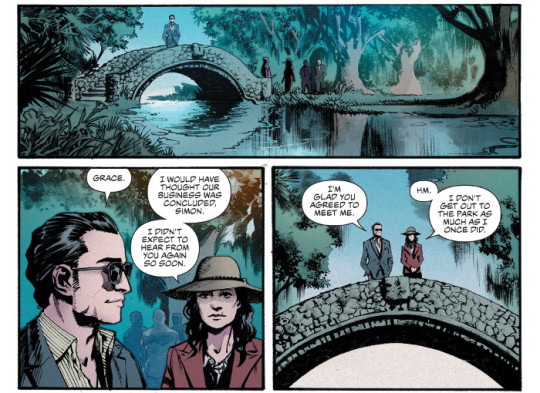

Brothers Dracul #5 circles back around to the beginning of the story, as we reach the end of this interesting retelling and interpretation of the intersection of both the historical and legendary story of Vlad the Impaler, from Cullen Bunn, Mirko Colak, Maria Santaolalla, and Simon Bowland. There’s an interesting twist here that certainly paints Vlad’s action in a different light, and I hope we see it followed up upon in a second series.
| Published by AfterShock

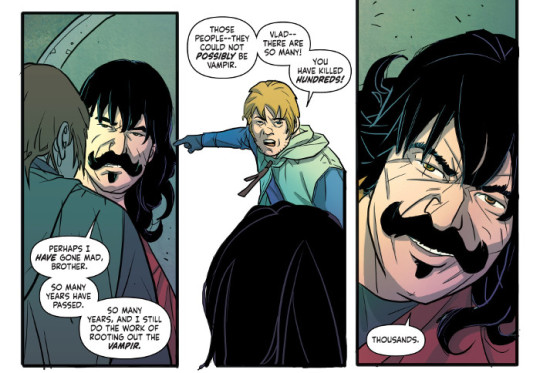

Cyber Force #5 is a nice change of pace as Bryan Hill, Matt Hawkins, Atilio Rojo, and Troy Peteri introduce us to another old familiar face. This incarnation of the team definitely is taking its time to be brought together, but when the storytelling is as entertaining and the artwork is as gorgeous as this, it doesn’t really matter. To note, though, this is not the kind of decompression that feels empty or padded, it’s just fleshing out characters and their lives more than what we’ve seen before.
| Published by Image / Top Cow



Daredevil Annual #1 presents a standalone story of Misty Knight’s days as a detective and her first meeting with Daredevil. It’s good. It feels a bit more like a pilot for a Misty Knight series than necessarily a Daredevil tale, but, as I said, it’s good. The art from Marcio Takara and Marcelo Maiolo is nice. I really like Takara’s style which gives me hints of Phil Hester, Jim Mahfood, and Tomm Coker.
| Published by Marvel

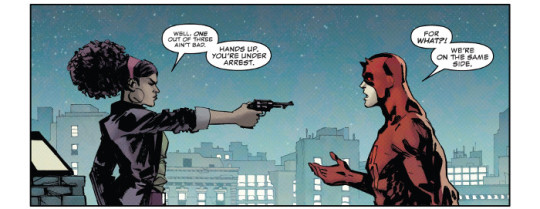

Dungeons & Dragons: Evil at Baldur’s Gate #5 is another fun one, with a focus this issue on Boo. I’ve really enjoyed this series, with Jim Zub giving the party a bit of a breather between larger adventures and giving a great look at them as individual characters. Great art, too, including this issue from Francesco Mortarino and Jordi Escuin.
| Published by IDW

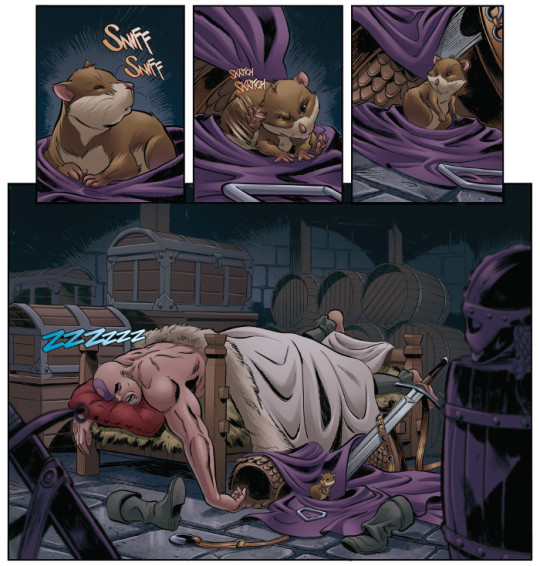

Edge of Spider-Geddon #2 gives us a view into another alternate Spiderverse, circling back around to SP//dr, and giving us a new twist on the power and responsibility rubric and VEN#m. It’s nice to see Lonnie Nadler and Zac Thompson play with more technological horror, with some incredible artwork from Alberto Alburquerque and Tríona Farrell.
| Published by Marvel



Euthanauts #2 is a thing of beauty. Nick Robles and Eva De La Cruz are seriously delivering some of the best art in comics right now with this series. The page layouts, character designs, use of colour, and incorporation of lettering choices from Aditya Bidikar, just elevate the storytelling immensely. Not even to mention how Tini Howard is making the weird science seamless in the dialogue. This is great.
| Published by IDW / Black Crown



Exiles #7 concludes the Old West-ish arc with cowboy T’Challa. Drop dead gorgeous artwork from guest artist Rod Reis. His depiction of the ultimate villain here shows some nice influence from Bill Sienkiewicz.
| Published by Marvel



Extermination #2 brings the fight to the school, even as the team (and the reader, although it’s not a bad thing) is still confused as to what is really going on. I love this, the tension that Ed Brisson, Pepe Larraz, and Marte Gracia are building is palpable, and the hints of kid!Cable’s actions are chilling. Also, the art is just phenomenal.
| Published by Marvel

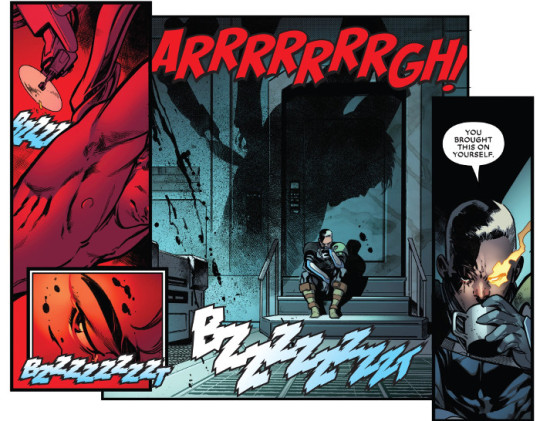

Harbinger Wars 2 #4 is kind of the end to this, but the ramifications and fallout are all supposed to appear in the Aftermath issue. That being said, Matt Kindt, Tomás Giorello, Renato Guedes, Diego Rodriguez, and Dave Sharpe go all out for the spectacle in this final confrontation between Livewire and X-O Manowar. It is still kind of insane how Capshaw could possibly consider what GATE and OMEN have done as being “good”, especially in light of Palmer going absolutely batshit insane, but it does lead to interesting set-up for future conflicts.
| Published by Valiant

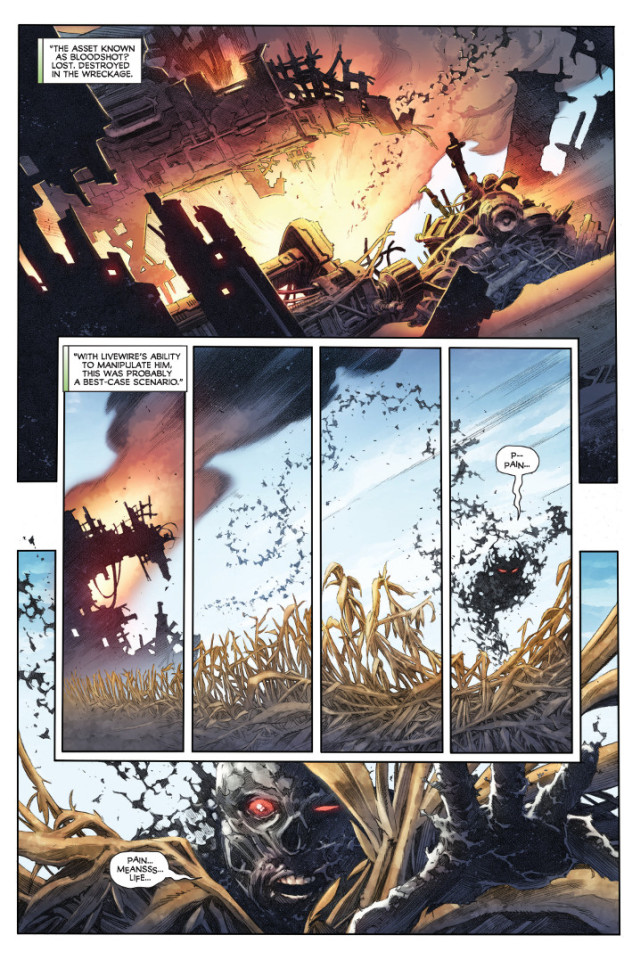

Hillbilly: Red-Eyed Witchery From Beyond #1 begins the next adventure of the black-eyed tramp. I get a bit of a Beowulf vibe from Eric Powell’s set-up and I’m interested to see where it goes. This series sees Powell passing on the artistic duties to Simone Di Meo, Brennan Wagner, and Warren Montgomery and it’s an interesting visual shift from the washes of Powell’s own work in the original series. I quite like Di Meo’s style, which reminds me a bit of James Harren and Troy Nixey.
| Published by Albatross Funnybooks



House Amok #1 is something I’m not sure I can describe. It’s kind of a family drama, but if that family were all collectively sharing a hallucinatory experience or delusion. It’s a very interesting concept that’s only partially revealed by Christopher Sebela, Shawn McManus, Lee Loughridge, and Aditya Baker, but it leads to a very compelling start here. Gorgeous artwork from McManus and Loughridge.
| Published by IDW / Black Crown

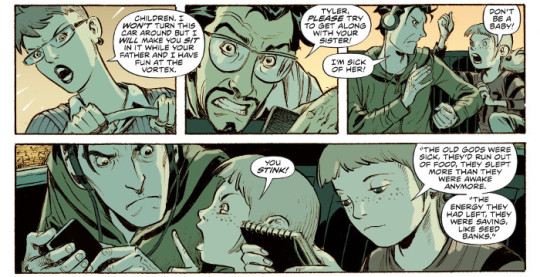

Hunt for Wolverine: Dead Ends #1, like all four of the Hunt for Wolverine mini-series, is kind of a bit of treading water. I cannot say it or any of the previous series are bad, taken on their own separated from this “event”, they’re usually quite good, but as a whole it’s kind of disappointing. It’s a search for Wolverine that kind of comes up empty, acting as a prequel to the return of Wolverine, despite already having returned in Marvel Legacy and hopped across numerous different titles, before apparently being used for evil, as per throwaway bits in the fourth issues of those previously mentioned minis that didn’t necessarily connect with the plots of those minis. It feels a bit scattered and unnecessary, unfortunately, especially when it comes to comparing notes, coming up with the organization we already knew was behind it, and a bit of hand-waving mystery and grandstanding that still tells us a whole lot of nothing. It’s sound and fury. All of which is a bit of a shame because I otherwise generally enjoy the work of Charles Soule and Ramon Rosanas.
| Published by Marvel



Isola #5... Just look at the artwork. Karl Kerschl and Msassyk just keep delivering page after page after page of beauty.
| Published by Image

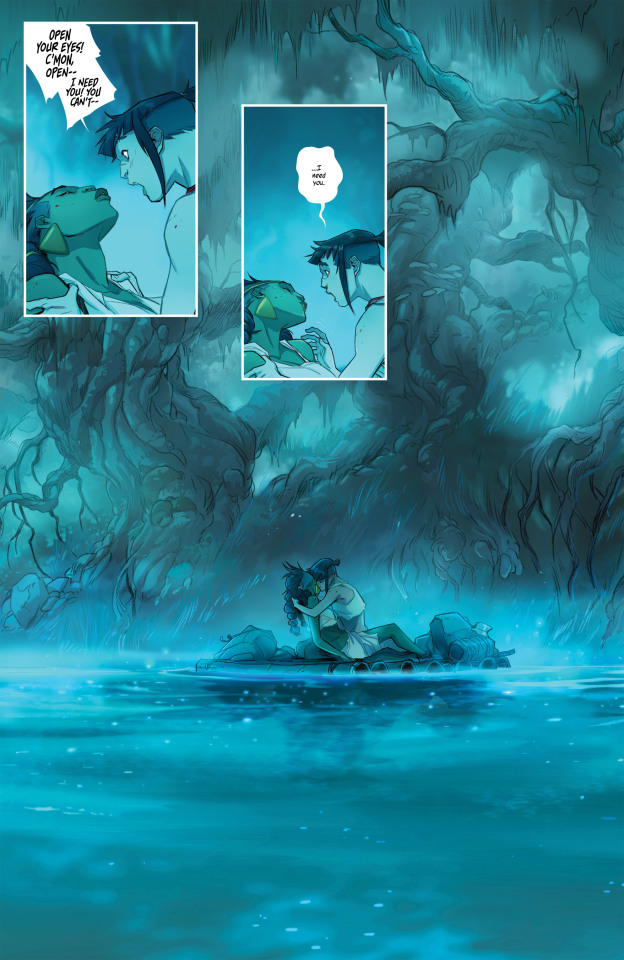

Jessica Jones #2 reaffirms that this is one of the best things that Marvel is currently publishing, with the next two chapters in this story. Kelly Thompson’s dialogue, narration, and banter throughout this issue is spot on, propulsive, and funny as hell when it needs to be, but what elevates it is that this isn’t your typical talking heads approach. The characters are doing stuff, like hunting sea monsters, instead of sitting at a desk or whatever. It’s a refreshing change that overall just makes this all the better. Not to mention Mattia De Iulis’ stunning artwork. It’s slick and polished with a line style that somewhat reminds me of Paul Gulacy and a bit of Rick Mays, and an approach to shadow and colour similar to Frazer Irving. This is a great series that really shouldn’t be missed.
| Published by Marvel



Judge Dredd: Under Siege #4 wraps up this entertaining series from Mark Russell, Max Dunbar, Jose Luis Rio, and Shawn Lee. I really like Dunbar’s take on Dredd and the Russell’s idea of people creating their own law in the absence of law is an interesting philosophical counterpoint to the idea of man naturally sliding towards a state of chaos. Even the mutants striving for society is an interesting challenge to the typical idea of things falling apart.
| Published by IDW



New Mutants: Dead Souls #6 concludes the series with Illyana putting the pieces together for what actually has been going on, it isn’t a pretty picture. This has been a great series from Matthew Rosenberg, Adam Gorham, Michael Garland, and Clayton Cowles and the revelations this issue are heavy. The implications for the X-universe is huge and I want more.
| Published by Marvel

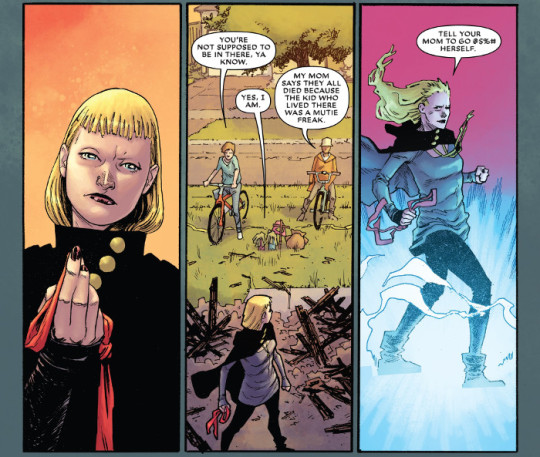

The New World #2 essentially reveals itself as a romance comic, amidst the ultraviolence and social engineering. Didn’t really see that coming, but it’s an interesting move. Trippy art from Tradd Moore, Heather Moore, and Ludwig Olimba.
| Published by Image



Paradise Court #2 continues to be an entertaining horror comic from Joe Brusha, Babisu Kourtis, Leonardo Paciarotti, and Taylor Esposito. This gives us the part of the story where our protagonist is experiencing the horror and everyone else is telling her she’s just imagining it, but it’s still well told and well illustrated.
| Published by Zenescope

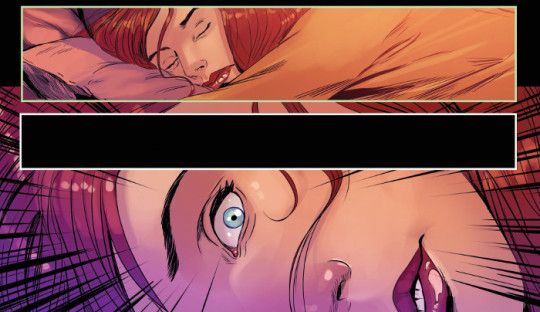

Rick and Morty vs. Dungeons & Dragons #1 is about as perfect a crossover of two properties as you can get. Morty trying to get into D&D because he thinks it will get him laid is the perfect in to the world of the game and the cartoon, perfectly blending the two for fans of both without alienating or diminishing either. Jim Zub, Patrick Rothfuss, Troy Little, Leonardo Ito, and Robbie Robbins are faithful to both and in doing so deliver a wonderful beginning to this story, that also educates along the way.
| Published by IDW & Oni Press

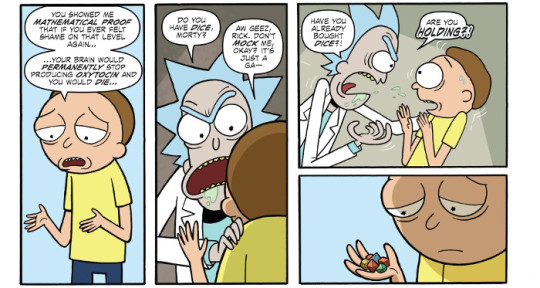

Runaways #12 is easily one of the best issues in what has already been an exemplary series. Rainbow Rowell, Kris Anka, Matthew Wilson, and Joe Carmagna focus here on forgiveness, acceptance, and second chances, with some truly beautiful character work between Gert & Victor and Nico & Karolina. If you don’t have a giant grin on your face by the end of the issue, I question your humanity.
| Published by Marvel



Submerged #2 is still weird, very weird, but there’s some really good bits in here demonstrating some of the emotional manipulation that family members sometimes employ. Beautiful, ethereal artwork from Lisa Sterle and Stelladia.
| Published by Vault



Venom: First Host #1 is somewhat strange to see in light of where Donny Cates and Ryan Stegman have taken the character, but this limited series from Mike Costa, Mark Bagley, Andrew Hennessy, Dono Sánchez-Almara, and Clayton Cowles serves as both an interesting addendum to the symbiote’s history and as a continuation (and likely capstone) to the previous creative team’s run. It’s pretty decent.
| Published by Marvel

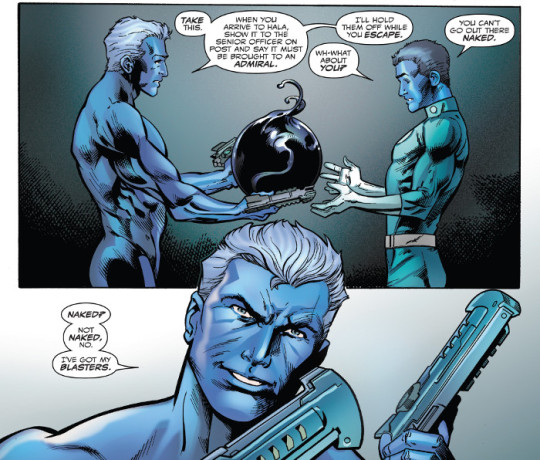

Web of Venom: Ve’Nam #1 is a one shot fleshing out the backstory of Rex Strickland and the SHIELD experiment that bonded the early symbiotes to soldiers set loose during the Vietnam War. It’s an entertaining tale with some nice guest stars and sweet art by Donny Cates, Juanan Ramírez, Felipe Sobreiro, and Clayton Cowles. I particularly like the scratchy, faded look in the art to make it look a bit “old”.
| Published by Marvel

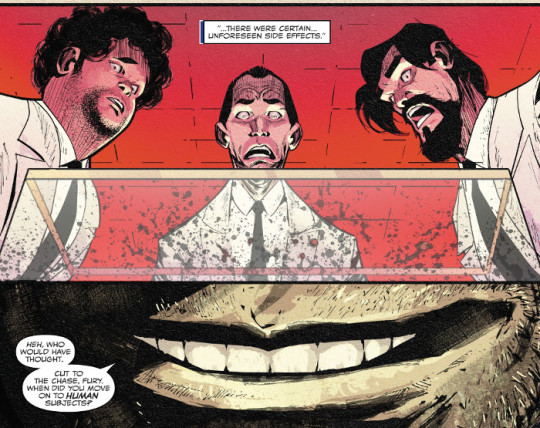

X-23 #3 is great. Mariko Tamaki has nailed the characters and the art from Juann Cabal and Nolan Woodard is incredible. The page designs alone elevate the storytelling immensely.
| Published by Marvel

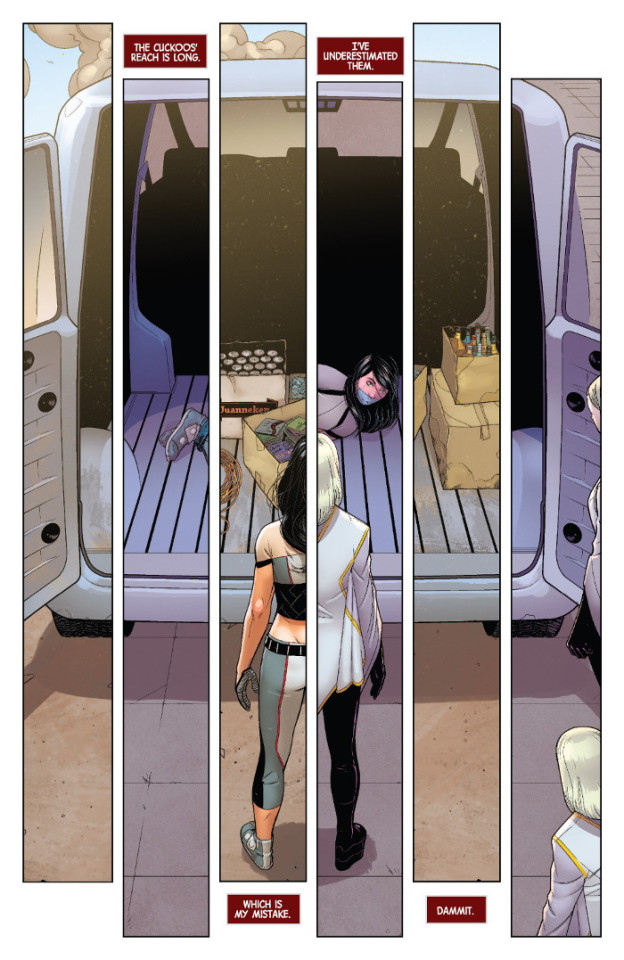

The X-Files: Case Files - Hoot Goes There? #2 concludes the second of this new approach of a series of mini-series and it’s...weird? Funny, but weird. Definitely taking a page out of some of the more outlandish episodes of the series, where you question whether or not what you saw happened actually happened. Still, it’s entertaining, which is all that really matters. Fun from Joe and Keith Lansdale, Silvia Califano, Valentina Pinto, and Shawn Lee.
| Published by IDW



X-Men Blue #34 looks like it largely serves as a capstone to Cullen Bunn’s work with Magneto over the past four years or so, as he winds down his run here and continues to tidy the characters up a bit before he’s done and hands the reins off to the next band of storytellers. It feels like there’s a lot more here that he would have like to have told, but what we get here is still excellent. The hints at the next stage for Magneto and mutantkind are intriguing. Great art from Marcus To and Matt Milla.
| Published by Marvel



X-O Manowar #18 gives an interesting transition from this flashback of Aric’s pre-Shanhara life to his return to Earth, focusing on how ideas, people, and culture keeps changing. Matt Kindt delivers a pretty chilling reaction to it. All with some nice artwork from Trevor Hairsine, Brian Thies, and Diego Rodriguez.
| Published by Valiant

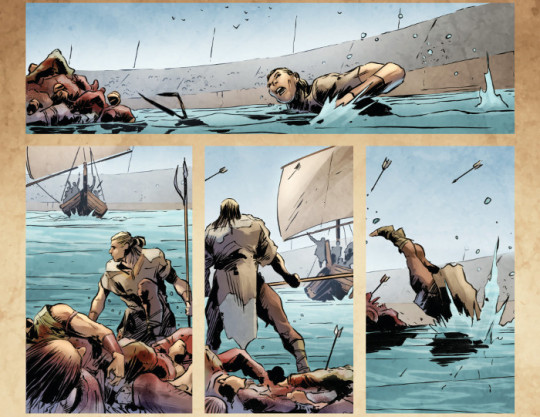

Other Highlights: Deadpool: Assassin #6, GI Joe: A Real American Hero #255, KINO #9, Marvel Two-in-One #9, Mighty Morphin Power Rangers: Shattered Grid #1, Modern Fantasy #3, Moon Knight #198, Ms. Marvel #33, Red Sonja #20, Rick & Morty #41, StarCraft: Scavengers #2, Star Wars: Lando - Double or Nothing #4, Star Wars: Poe Dameron Annual #2, Star Wars Adventures #13, TMNT: Bebop & Rocksteady Hit the Road #5, Wayward #28, X-Men: Grand Design - Second Genesis #2
Recommended Collections: 2021 - Volume 1, 30 Days of Night, Big Trouble in Little China: Old Man Jack - Volume 1, Black Cloud - Volume 2: No Return, DuckTales Classics - Volume 1, Eugenic, Factory, Femme Magnifique, I Hate Fairyland - Volume 4, James Bond: Hammerhead, Judas, Killer Instinct, Stray Bullets: Sunshine & Roses - Volume 2

d. emerson eddy is not the very model of a modern major general. Nor a scientist salarian for that matter.
8 notes
·
View notes
Text
Season 13 and the Big Bad
A defining characteristic of Supernatural in seasons past was the early identification and buildup of the Big Bad character of the season, to the degree that the cosmic escalation of big bads became a running joke. And then the show itself transcended the running joke with the whole “God’s SISTER!” thing, and honestly, where the heck do you even go from there.
Demons, Bigger and Scarier Demons, More Demons, Apocalypse-starting Demons with a side of Dick Angels, Lucifer and Michael, Raphael and Monsters, Leviathan, Demons and basically the Winchesters screwing with the natural order, Angels and Bigger and Badder Demons, MoC!Dean, God’s Sister the Darkness…
I mean who else was waiting for Fuckhands McMike to show up?
Once you hit that level, the whole IDEA of a single season Big Bad just… loses the power to engage. Almost everything after that point is gonna have a Been There Done That element to it.
That’s why the whole point of s12 wasn’t about a Big Bad Character, it was about the Winchesters finally having moved out beyond the plot far enough to look back at their legacy in a critical way. The BMoL weren’t there to act as the Big Bads, despite filling in part of that role. Same with Lucifer. Same with Mary. The real Big Bad of s12 was the Winchesters’ past, their legacy, their “destiny.” And finally beginning to find some sort of resolution and a fuller understanding of themselves. And that theme is continuing full-steam ahead in s13.
The real Big Bad is the friends we made along the way.
Nah, just kidding. The real Big Bad of s13 so far is Dramatic Irony. But let’s back up and examine the players on the board so far:
(under a cut because it’s like 3.6k words and this just seems practical, if annoying) :P
--There was much speculation that Wee Lil Nephilim Jack could “grow into his power” and become the season’s Big Bad, and 13.01 certainly tried hard to make us believe it… for about 15 minutes. He’s certainly got a terrifying amount of power at his disposal, but he’s such a lil marshmallow and just wants to be GOOD so badly. Just give him some nougat and watch him struggle to understand human morality with his Beyond God-like Abilities. So while he’s definitely a source of Major Cosmic Disruption, he can’t really fit the Big Bad bill.
--In 13.02 we met the Kentucky Fried Demon, the last yellow-eyed Prince of Hell, Asmodeus. Thanks to later retconning, we’ve tied yellow-eyed demons right back to the opening scene of the entire series, and the Inciting Incident of all the drama we’ve watched unfold over the last 12+ seasons. And the last one standing has now also been referred to by Lucifer as the “least” of his creations, yet Asmodeus has had a few surprises up his sleeve-- including his shapeshifting. But for all his inexplicable raw power to even confidently best Lucifer in a head to head fight, what are his actual goals? We know he’s long wanted to release the Shedim from Hell, but to what end? What does he even want? He talks a big game, but does he even have a Big Plan? Halfway through the season, we just don’t know, and as a result Asmodeus reads more like a cartoon than an actual threat, despite his “weirdly strong” powers.
--The Empty Entity, which after 13.04 I saw numerous posts speculating that maybe the Entity would grow weary of sleeping (or of being woken up by other angels and demons who somehow began awakening as a result of Cas’s disturbance to the force). But really, the essential nature of that force is… the opposite of interfering in reality. Much as God’s powers of creation held no power in the Empty, the Empty’s eternal stasis can’t hold power within Creation. Obviously Jack’s powers are somehow capable of bridging the gap between them, the same way he’s able to bridge the gap between alternate realities, but so far, the Empty Entity seems like a one-off.
--Billie as the New Death. I, for one, am SO GLAD she’s back, and that the mantle of Death has finally passed on to her. I’d been screaming about her being the New Death since 11.02, and she’s finally come full circle and stepped into that role. As such, she’s in a position to see the full scope of the Cosmic Circumstance, and her previous insistence on what amounts to a tiny cosmic imbalance of the Winchesters’ continued existence is more like a tiny grain of sand out of place while the problems the Winchesters’ continued existence SOLVES is like an entire beach crumbling away. As the linchpins holding the multiverse together, she’s counting on the Winchesters being ALIVE now. Hardly seems Big Bad-ish to have thrown her lot in with the protagonists of the piece, yes? She still has cards to play, especially after warning Dean about the cosmic house of cards and its current precarious state due to Jack’s interference with multidimensional affairs. Rather than having an agenda to do harm, like the Old Death, Billie serves more of a bellwether role. She’s a neutral force that’s acting within her powers to at least drop hints and warnings to the Winchesters.
--Lucifer has incredibly found his way back to the story AGAIN. Like, why won’t he just DIE already? *sighs heavily* At least now he’s been officially de-powered by AU Michael to the point where he’s become rather… ineffective. Poor thing and his little stick. So far, since he’s returned to the regular universe, his function has been running around Chicken Littling at everyone. Ironic since his main stumbling block so far has been his own personal Colonel Sanders impersonator. *cue all the chicken/egg metaphors* *something something chickens coming home to roost* *finger lickin’ good* It’s hard to take those sorts of parallels too seriously.
Just as Asmodeus is the “weakest” incarnation of a Yellow-Eyed Demon who has become “weirdly strong” mostly through the emotional significance that Yellow-Eyed Demons have held for the length of the entire series, Lucifer has become “weirdly weak” himself despite the effect his mere presence has just looming over the entire narrative since he was first mentioned way back in s3. His power is now largely symbolic through the psychological trauma he inflicted on Sam (and now as of 13.12, on Rowena). His Big Bad status seems far more weighty on a personal level for the Winchesters (and particularly on Sam), in finally confronting how their cosmic destiny has truly fucked with their lives.
Lucifer himself, meanwhile, has spent most of the season impotently locked in the AU, physically locked in AU Michael’s Iron Maiden, physically depowered by AU Michael’s rift-opening spell, and then tossed around by his “weakest” creation and locked in a cell for the last six episodes. Granted this gives him motivation for taking action, but his obsession with destroying Michael still seems to be his underlying motivation. Sure, he’s still interested in saving “the last perfect handiwork of God,” i.e. the natural world, but he still doesn’t give a damn about humanity. As of 13.12, the most danger he represents is the fact that the Winchesters have no idea he’s back in this world, and that he’s not the one holding Mary captive in the AU and torturing her. Which brings us tidily to…
--AU Michael. The Ultimate Big Bad of s5, at the end of the day, was Michael. He was the one who insisted on sticking inflexibly to his “destiny.” The “good and obedient son” who was prepared to carry out what he believed he had to, despite every opportunity to resolve the apocalypse peacefully and just choose not to fight. Even LUCIFER tried to make peace with him when they finally met at Stull Cemetery, and yet Michael regarded it as yet one more act of “disobedience” from his disobedient brother. And in the AU, their version of Michael actually won the big throwdown, and as a result left the entire planet a wasteland. Lucifer may have wanted humanity wiped off the planet, but witnessing the destruction of all of God’s creation was a shocking reminder that he never wanted to destroy nature… Michael didn’t even care, as long as he’d fulfilled his destiny. How… righteous (in the worst possible sense of that term, bordering on self-righteous). That has some Big Bad makings, no?
The problem with Michael so far this season is that he’s already succeeded in destroying his version of Lucifer, and destroying his own Earth in the process. It’s a fait accompli in his world, but as soon as he stumbled across the rift and learned of another world where he’d failed in the past, he’s been rejuvenated with fresh purpose. It seems almost compulsive for him-- Find World, Destroy World. It’s like his Prime Objective, and he’s incapable of NOT living up to that destiny. It doesn’t make him a Big Bad, just based on that alone, but it does give viewers the ol’ raised eyebrow of suspicion, just based on Michael’s past history.
Not to mention, Lucifer’s pointed out several times that like Asmodeus who seems “weirdly strong” (and yes I keep harping on that phrase because the Plum Sisters were also “weirdly strong” in 13.12, and for Yockey to write such terribly awkward dialogue there HAS to be a purpose, aside from gently mocking standard Bucklemming dialogue), AU Michael is more powerful than the version that the Winchesters (including Cas) helped defeat in 5.22.
The fact that Lucifer keeps insisting that Michael is so powerful, that Michael always gets his way, for those of us actually WATCHING the show, that’s just… blatantly false. The one thing Michael wanted most back in s5 was for Dean Winchester to say yes to him. It’s the one thing he never got. Because Dean’s will proved stronger than Michael’s sense of destiny and obedience. Back in 5.22, Michael rendered himself irrelevant when TFW “ripped up the ending.” The AU where this version of Michael is from never had the Winchesters to contend with, and so has never had to confront the true power of Free Will. Honestly? With TFW 2.0 resurrected from the ashes, how big of a threat does AU Michael truly pose? Because from OUTSIDE the story? No matter how “weirdly strong” that Michael is, it looks more like he and Lucifer are playing out the same pantomime they did back in s5, with just as much chance of actual success as they’d had back then.
What Michael and Lucifer DO bring to the story right now isn’t so much their power to be New Big Bads, but their power to bring the PERSONAL trauma that Sam and Dean (and Cas, by extension) went through as a result of the original setup and downfall of the Apocalypse, and an outlet for them to finally examine the emotional and psychological fallout of what they’ve suffered through and sacrificed to keep the universe from derailing itself over and over again. Which brings me to…
--The interdimensional rifts themselves. Billie had warned Dean about the cosmic house of cards that was dangerously close to toppling as the characters become more self-aware, and realize there are actually ways to cut through to other universes where they might find a way to give themselves a mulligan… where they might be able to “start all over again,” where they made different choices that led to different results. But the stability of the multiverse relies on individual realities maintaining internal continuity, and not bleeding over into one another at random. Which brings me back around to what Chuck told Dean when he left Dean in charge of the universe back in 11.23, and which Dean referenced in his anguished plea for help in 13.01, namely…
--Dean’s not only the “firewall between light and darkness,” but he’s been set in place as the figurehead for balance in the universe. He’s been appointed the guardian of creation by proxy, and hell he really doesn’t want the job. And yet who else is even going to try? Is that what Lucifer is trying to do, at least on the surface? Is that what Cas is attempting in trying to find Jack? Is that what Sam’s attempting in trying to help Jack learn what it means to be human versus a monster?
--Heaven and their Endangered Species Repopulation Project. It seems the angels are growing more desperate as their numbers dwindle. They’ve mostly ceased their interference on the mortal plane, aside from their desperate quest to find and use Jack’s powers to replenish their numbers. But considering Jack’s power level, it doesn’t really seem like much of a real threat to Jack himself. Considering the burst of power that came from Jack’s “power up” of Kaia, that seemed to make BOTH of them “weirdly powerful” enough to tear open another rift and simultaneously nuke six angels. Something tells me that if Jack wanted it enough, he’d have the power to snuff out pretty much any threat to himself. Sure, he’s trapped in the AU right now, but even that’s effectively removed him from the angels’ grasp anyway. It’s been a non-issue for the most part, and in the overall scheme of things, doesn’t seem like a top priority concern for anyone right this second...
--and finally, after 13.12, Rowena’s true nature and full powers have finally been unbound. What is she? What will she do with her powers? What are her goals now that she’s finally been restored to her full power? Will she retain reluctant Frenemy status with the Winchesters? Will she actively seek revenge against those who wronged her, primarily Lucifer? Will she make a play for power in revenge for Crowley’s demise? What does she even want now that she’s attained the personal freedom and safety she’d been seeking since her first introduction back in s10? Right now, she’s a wild card, but we do love her dearly, and I’m glad she’s back. :)
So… who’s really the big bad?
Between the season’s major themes of “things that look like other things,” and things not being what they seem on the surface, as Lizbob’s been saying all season, the Big Bad seems to be Dramatic Irony. The story ITSELF is its own worst enemy.
It’s the narrative structure screaming, “What you don’t know absolutely can and WILL hurt you.”
And all of this is being delivered through the resurfacing of old friends in slightly “off” ways. How many characters and cases and circumstances have directly pinged circumstances from the Winchesters’ past? Going right back to the opening scenes of 13.01, and the “vision” Dean had after Jack knocked him and Sam out-- the flashback to Mary burning on the ceiling overlaid against her being dragged through the rift by Lucifer in 12.23. The entire setup of that scene was rife with flashbacks to Sam losing Jess in the pilot episode, the woman in white played by Kelly Kline, the yellow-eyed monster in the nursery played by Jack, and Cas playing the role of the loved one who was burned and therefore was supposed to “stay dead.” But Mary had already defied that assumption, because she didn’t stay dead. Cas didn’t stay dead either. And now Rowena has also defied that particular truism...
Right from the start of the season we’ve been confronted with things from the past, but which only hint at the past because they’ve now either been applied to different things, or they’ve been transformed into something different, or encountered under entirely different context.
--The “Black Spur Bar,” which had previously been Demon!Dean’s hangout during his summer of love with Crowley was transformed into an entirely different bar where Dean mourned Crowley’s death and was unwittingly confronted by a new demonic adversary (dramatic irony!).
--Donatello the prophet, now purposeless in this post-prophecy, post-God world, left to live on without his soul, and yet still doing the best he could in the circumstances he was left with.
--Literal Alternate Universe versions of lost friends-- from Bobby to Kevin, to mentions of John and Mary and their existence in that other world. There’s no bigger metaphor for “Things that look like other things” than literal alternate versions of loved ones…
--Missouri Moseley, absent from the narrative for thirteen years, returned to pass on her legacy to her granddaughter, who’d been raised to doubt her own psychic powers and has now been forced to face what having those powers means for her.
--Not to mention Patience Turner’s last name dredges up questions about who the “Turner” who gave his name to James and Patience may have been, and as I sit here watching 11.16 I’m again reminded of the speculation that maybe it was actually Rufus Turner… we may never know, but heck, it’s definitely not wild to believe it might be true.
--Buddy the shapeshifter, in the sense that nobody is GIVEN the name “buddy.” It’s a nickname, and one that Dean has used many times in the past for Cas. But “Buddy” by his very nature… wasn’t. He impersonated Dean and attempted to shoot Sam. He wasn’t their “buddy” either.
--I mentioned her above, but Billie is no longer what she was before. She’s not a reaper, nor a dead reaper, but has been returned to the story as Death.
--The reaper who comes to collect Dean (and who Dean defies) in 13.05 is named JESSICA. That name is never spoken lightly in Supernatural. It’s a name nearly as loaded with personal baggage for the Winchesters as Mary or John, and again resonates straight back to the pilot episode of the series.
--Themes of monsters and the old west and cowboys and time travel (it was an antique pocket watch that even tipped Jack off to the case in Dodge City in the first place), with Cas now fully reintegrated with TFW, all call back to 6.18, even with the same musical cues, but the themes have all been twisted around sideways and reframed to new purpose. The fight’s no longer about external monsters and stopping the apocalypse, but internal monstrousness.
--We all thought Arthur Ketch was dead until he showed back up pretending to be his own “good twin.”
--We all also thought Rowena was dead.
--Nick’s Bar, where Lucifer chose as a convenient spot to have a chat with Cas about the potential Apocalyptic Situation they may be facing… while Lucifer’s now perma-trapped in the vessel formerly known as Nick…
--The new King of the Crossroads who survived less than the run of a single episode before being dethroned… He thought he could be the next Crowley, and Dean slapped him down with the truth, calling him “Some random demon.”
--Smash, aka Alice; the human dragged against her will into matters Supernatural, who pretty much everyone saw and immediately yelled OMG CHARLIE.
--The return of the Wayward crew, Jody, Donna, Claire, Alex… but now they’re no longer victims of the narrative. They’ve got their own entire spinoff. :P
--The Bad Place. Aka Purgatory Redux.
--Darth Kaia
--A monster auction that put the Winchesters on the chopping block, run by an FBI agent who literally served the monster population, in contrast to Human Authority Figures of the past, up to and including the BMoL who’ve fairly unilaterally wanted to destroy monsters in favor of protecting humanity.
--In that same episode, we finally see a bit of Donna’s personal life-- from her care for her niece to her relationship with Doug 2.0, and Doug’s ultimate rejection of the hunting life when he’s finally introduced to it.
--Jamie, aka Dean’s temporary “soul mate” in 13.12, was also the name of the bartender in 4.05 that was symbolically Dean’s “new first time” after having been “rehymenated” after his resurrection from Hell.
Not to mention Various and Sundry Villains, the theme this season being “Not what it appears to be,” as demonstrated at its most basic visual level with physical masks and hoods obscuring identity, monsters that take on different faces like shapeshifters and ghouls, or force their victims to PERCEIVE an altered version of reality such as the wraith.
Things are not what they seem on the surface, and the entire plot, the monsters of the week, and even ALL the potential “Big Bads,” and the narrative structure itself-- which is turning around and around this central point of Dramatic Irony-- is the fact that even us as the audience to this entire spectacle, with our added insight into SOME of the dramatic irony playing out week to week, even WE still do not see the bigger picture.
I'm cautiously optimistic that a lot of the Winchesters' problems regarding what they Don't Know will resolve when Cas joins up with them again. Cas holds a lot of Important Information that Sam and Dean need. They’ve been kept as much in the dark as a result of Cas’s imprisonment as Cas himself has. But even through the early part of the season, the validity of information they’ve worked off of has been suspect at best. The info they got from Jack's Vision Download in 13.09 wasn't the WHOLE truth about Mary’s imprisonment in the AU. They’ve made several rather large inaccurate assumptions based off that quick glimpse, though. Just like Patience's vision of Claire's death wasn't the WHOLE truth either, but it let to making several Big Choices that ended up having Massive Consequences.
Even when they think they're seeing the Big Picture Truth, there's still critical info missing from that picture.
The entire SEASON is the big bad wolf in sheep’s clothing.
That’s the entire POINT.
#spn s13 speculation#spn monsters#things that look like other things#narrative structure#dramatic irony is the the magnetic force holding all of s13 together
363 notes
·
View notes
Text
The Falcon and the Winter Soldier Episode 3: Marvel and MCU Easter Eggs Guide
https://ift.tt/eA8V8J
This article contains The Falcon and the Winter Soldier spoilers and potential spoilers for the wider MCU.
The Falcon and the Winter Soldier episode 3 might end up being remembered as the turning point of the series. A slow burn first episode led to some bigger revelations in the second one, but the third episode of the Marvel series is a bona fide sequel to one of the biggest MCU movies of all time in Captain America: Civil War. With a truly triumphant return for Sharon Carter and the re-introduction of Baron Helmut Zemo in a form that should feel much more recognizable to fans of the comics, there’s plenty of Marvel action to be had in “The Power Broker.”
Here’s what we found…
Dr. Wilfred Nagel
Wilfred Nagel was first introduced in Truth: Red, White, and Black, the same story that introduced Isaiah Bradley to Marvel Comics canon. The comics version of Nagel worked on the super soldier project back in World War II. After Professor Abraham Erksine’s death, Nagel was the one in charge of trying to recreate the process. He was the monster who killed hundreds of Black soldiers until succeeding by turning Isaiah Bradley into a super soldier.
And while Nagel’s comics super soldier program is designed to evoke the horrors of the Tuskegee Experiments, his description of his research in The Falcon and the Winter Soldier sounds more like a different injustice perpetrated on a Black subject: Henrietta Lacks.
Nagel describes working from “blood samples from a semi-stable test subject.” Henrietta Lacks was a young Black mother treated for cervical cancer in the early 1950s. The cancer proved fatal, but a collection of her cells sent to a tissue lab were remarkably hale, growing in the lab where other tissue samples would die out within 24 hours. The cell line cultivated from that sample would go on to be mass produced and used for a ton of biomedical research, even playing a critical role in the discovery of the polio vaccine.
Of course, all this was done without hers or her family’s consent. They didn’t even find out the cell line existed until 1975. That has led to a fight by her descendants and medical ethicists to give her the recognition she deserves for the part she’s played in helping human society, a movement that has only really taken off in the last decade.
Captain America: Civil War
Falcon is annoyed that Bucky won’t move his seat up. Their roles were switched during Captain America: Civil War.
Of course, that’s the only reference to Captain America: Civil War this episode. Just kidding!
Baron Zemo
This is the first time we see Zemo wearing his trademark purple mask. In the comics, Helmut Zemo was horribly burned by adhesives during a fight with Captain America and would hide his mutilated face with that mask.
When Bucky first enters Zemo’s cell, there is a reprise of Henry Jackman’s Captain America: Civil War score. Zemo was the central villain of Cap’s third MCU instalment, and Jackman returned to compose the Falcon and the Winter Soldier score for Marvel.
The Russian code words Zemo immediately uses – “longing, rusted, seventeen, daybreak, furnace, nine, benign, homecoming, one, freight car” – no longer activate the Winter Soldier, but Zemo attempts to press Bucky’s psychological buttons throughout the episode in other ways, and also tries to sow doubt in Sam’s mind about just how “healed” Bucky is from his time as HYDRA’s deadly assassin.
Zemo reveals he is currently reading the works of influential Italian Renaissance diplomat, philosopher and writer Niccolò Machiavelli. This is spectacularly on the nose, as Zemo is just about the most Machiavellian Marvel Comics villain there is – known to use his powers of deception and treachery to play all sides in almost any equation.
Wait, Marvel just dropped the entire “Zemo is royalty” backstory in there like it was nothing! The Baron has officially joined the MCU – with all that entails.
Zemo says that Sokovia has been gobbled up by neighboring states after the Avengers’ battle in Avengers: Age of Ultron left its city in rubble. He rhetorically asks whether Bucky and Sam have been to the memorial, and naturally they haven’t. We’ve seen a glimpse of Helmut standing in front of a memorial statue in trailers for The Falcon and the Winter Soldier, so he may go and pay his own respects at some point.
We also see that some time spent in the slammer has done nothing to change Zemo’s mind on the legacy of superheroes and super soldiers. He still believes they must be wiped out, and murders Nagel in a heartbeat when he thinks he has a chance to end the Super Serum line. Make no mistake, Bucky has a target on his back a mile wide where Zemo is concerned, and we don’t think Zemo will hesitate to kill Bucky as soon as the time is right.
Bucky as Captain America
This is the first time Bucky has suggested that he wield the shield. Not only has this happened in the comics for a time (with Zemo being part of his downfall), but previous Captain America movies have planted the seeds by regularly having Bucky wield the shield in the heat of battle.
So Bucky doesn’t just have a notebook like Steve’s, it IS Steve’s. Wonder if Zemo saw his own name in there?
Sharon Carter
The Sharon Carter we catch up with in episode 3 is much, MUCH closer to her Marvel Comics counterpart – in that she’s badass af – but this Sharon is also extremely jaded after going on the run, and is clearly involved in some other murky business that us viewers are being kept in the dark about, for now.
This is the first episode of The Falcon and the Winter Soldier written by John Wick franchise creator Derek Kolstad, and Sharon Carter becomes the MCU’s version of Wick. Just when she thought she was out, they pull her back in, and she has the unenviable job of fighting a series of Madripoor’s most eager assassins single handedly.
The Power Broker
In case there’s any doubt who holds a lot of influence in Madripoor’s Low Town, there’s some prominent graffiti that promises “The Power Broker is Watching”.
The Power Broker wants that Super Soldier Serum pretty bad, and with Nagel now dead thanks to Zemo, Karli Morgenthau is suddenly holding a lot of bargaining chips.
Any guesses on who the Power Broker might be? There are still three blank slots during the end credits. One of them is surely for whoever is playing the Power Broker. Who could the other two be for?
John Walker
We don’t spend a ton of time with John Walker in this episode, but we see the character’s harder edge increasingly creeping through. His “DO YOU KNOW WHO I AM” feels very much like how the character used to behave during his early post-Captain America days as the U.S. Agent in the comics. John has a bit more nuance here on the screen than he did in the comics, but they clearly aren’t going to shy away from this aspect of the character.
Madripoor
Madripoor is one of the most famous fictional locations in all of Marvel Comics history, first appearing back in New Mutants #32 in 1985. It has pretty much always been primarily associated with the X-Men throughout its history (especially Wolverine, who liked to use Madripoor as his favorite personal vacation spot), but plenty of other Marvel heroes have found trouble in Madripoor through the years (including both the Clint Barton and Kate Bishop versions of Hawkeye, so don’t be surprised if we return here during their series). Of course, there are still no firm plans about how mutants will eventually be introduced into the MCU, this would be a fine place to start looking for clues.
The monkey sign was probably the entrance to the Brass/Bronze Monkey Saloon, a bar we visited back in the very influential Gruenwald Captain America run. Crossbones took Cap’s kidnapped girlfriend, Diamondback, there as he was running from the hero.
When talking about Madripoor, Falcon compares its ominous description to Skull Island, home to King Kong. Funny to drop that reference on the week of Godzilla vs. Kong‘s release. Unless this is referencing a totally different Skull Island. Did the Red Skull have his own island in the MCU?
The Princess Bar
If you’re looking for any big X-Men mutant clues, you should probably start with The Princess Bar itself, which in the comics is owned by Wolverine. But other than that, we didn’t get much in the way of mutant stuff out of these scenes.
Introduced in Chris Claremont and John Buscema’s story in 1988’s Marvel Comics Presents #1, The Princess Bar is owned by a man named O’Donnell and home to a bunch of Wolverine espionage shenanigans. At some point, Wolverine bought a silent partnership in the bar under his Madripoori alias Patch (Wolverine in a white tux with a patch over one eye, in the worst cover identity since that time Zooey Deschanel got rid of her bangs). These days in the comics it’s owned by Krakoa generally, as Captain Kate Pryde and her crew of Marauders are putting in quite a bit of work in Madripoor.
Snap Wilson
Falcon is annoyed because his Madripoor outfit makes him look like “a pimp.” For a time, Marvel retconned it so that when Steve Rogers met Sam Wilson originally, he was actually a pimp named Snap Wilson. Some time later, Marvel decided that this was in bad taste and undid the retcon. It has since been explained away as Red Skull trying to alter time and space with the Cosmic Cube, as he has been known to do.
Anyway, Sam’s “pimp” outfit is because he’s supposed to be masquerading as…
Smiling Tiger (Conrad Mack)
Smiling Tiger (Conrad Mack) is an archnemesis of the New Warriors who has, for a time, helped run the criminal underworld of Madripoor. Fittingly, while people may see Madripoor as the first step in seeing Wolverine show up in the MCU, Smiling Tiger’s comic incarnation has a noticeable resemblance to the famed X-Men member.
Trouble Man
cnx.cmd.push(function() { cnx({ playerId: "106e33c0-3911-473c-b599-b1426db57530", }).render("0270c398a82f44f49c23c16122516796"); });
Sam once again brings up Marvin Gaye’s Trouble Man soundtrack album, which he has been talking about literally from his first minutes onscreen in the MCU. He’s right, by the way, this album rules. Funny enough, this episode airs on April 2, which would have been Marvin’s 82nd birthday. Go listen to this album specifically or Marvin in general in honor of the man.
Black Panther
Bucky follows a trail of tech breadcrumbs at the end of the episode after previously warning Sam that Wakanda hasn’t forgotten the killing of King T’Chaka during an attack orchestrated by Zemo in Captain America: Civil War. Waiting for him in a quiet side street is Ayo (Florence Kasumba) second-in-command of the Dora Milaje from Black Panther, who is less than happy about Zemo’s freedom. We wrote more about what this is gonna mean for Sam, Bucky, and Zemo here.
The post The Falcon and the Winter Soldier Episode 3: Marvel and MCU Easter Eggs Guide appeared first on Den of Geek.
from Den of Geek https://ift.tt/3mezxhQ
0 notes
Photo

GODZILLA - A QUESTION OF ORIGINS: AN ESSAY ON GODZILLA’S PLACE IN PALEO-FICTION
Earlier this month Toho Studios and Polygon Pictures unveiled to the world the latest incarnation of Godzilla via a 2-meter tall statue erected in the lobby of the Cinecitta’ Theater in Kawasaki. While this new version of Godzilla, which will appear in the forthcoming anime film GODZILLA: PLANET OF THE MONSTERS (Nov. 17, Dir. Kōbun Shizuno & Hiroyuki Seshita), has an overall familiar silhouette, it is also in many ways radically different from anything that has come before it. With a forest green complexion, skin which looks like twisted roots and leaf-shaped dorsal fins, this new Godzilla has a rather arboreal look to him.
A subsequent press release from Toho published on Sci-Fi Japan provided further confirmation regarding Godzilla’s Swamp Thing-like new look by noting that this incarnation of Godzilla will be a “plant-based” life form. Needless to say this statement was fairly vague and raised numerous questions as to what exactly is meant by “plant-based.” Will Godzilla actually be a plant or part plant? Will he be an animal with a symbiotic relationship to plants? Maybe it just means he’s a vegetarian? It’s still too early to say but this has not stopped many Godzilla fans from reacting with consternation and condemnation (at least on this side of the Pacific, I have no idea what Japanese Gojira fans are making of all this). Much of this outrage stems from the fact that most fans take as gospel the idea that Godzilla’s origin is that of an extant dinosaur whose exposure to radiation from atomic bomb tests in the Pacific in the 1950s mutated the creature into the familiar kaijū known around the world today.
But is this actually the case?
It should be stated upfront that Godzilla’s creator, Toho Studios producer Tomoyuki Tanaka, is on record as saying that he originally conceived of Godzilla as “a dinosaur sleeping in the Southern Hemisphere [that] had been awakened and transformed into a giant by the [atomic] bomb.” However, Tanaka gave his statement to The Washington Post in 1984, many years after the fact and while promoting the then new film THE RETURN OF GODZILLA (1984, Dir. Koji Hashimoto) which, as we will see, was the first in a series of Godzilla movies which began placing greater emphasis on Godzilla’s connection to dinosaurs. Furthermore, digging into the production of the original Godzilla film from 1954 reveals that there was in fact no consensus early on regarding what exactly Godzilla should be. Special-effects director Eiji Tsuburaya campaigned for Godzilla to be a giant octopus while early concept art by cartoonist Kazuyoshi Abe depicted a monster more allegorical then biological in appearance, as it resembled an anthropomorphic living-mushroom cloud. It wasn’t until Toho art director Akira Watanabe took a pass at the design that Godzilla’s now familiar dinosaurian look began to emerge.
However this essay is not interested in events which transpired behind the scenes but rather those which ended up in front of the cameras. In other words, the question being asked here is if the commonly upheld assertion that Godzilla is a ‘radioactive dinosaur’ can actually be found in the 31-films which make up Godzilla’s current cinematic legacy. To this end, the following essay will look at those films in the franchise which both explicitly and implicitly deal with the subject of Godzilla’s origin in order to find out what is and is not actually said about the King of the Monsters and where he comes from.
As a final note before proceeding it should be observed that because the role of science in science-fiction films is often to merely lend a veneer of scientific veracity to the events on screen via the use of technical sounding jargon it should not be expected that the paleontological claims made by various characters in the Godzilla films are in any way accurate or a reflection of what actual paleontologists have ever thought was true about dinosaurs. Nevertheless, there are moments in the franchise where actual paleontology – both cutting edge and hopelessly out-of-date – has been invoked, balanced out by scenes of utter pseudoscience. Because of this fact, this essay will endeavor to highlight which ideas are true, which are blatantly false and which fall somewhere in between. What this essay will not attempt to do however is use the tenants of contemporary paleontology to try and explain Godzilla’s origin – mostly because I am not a paleontologist. Readers who are interested in that kind of speculation have a number of essays on this very topic written by actual paleontologists including Kenneth Carpenter, Darren Naish, and Mark Witton which they should consult.
Now on to the films…
Godzilla (1954)
In GODZILLA (1954, Dir. Ishiro Honda) Japanese fishing trawlers begin mysterious disappearing off the coast of Japan. When some of the survivors wash up on the nearby Odo Island journalist Hagiwara (Sachio Sakai) goes to investigate. He learns that the locals blame the disasters on a mythical monster called Gojira/Godzilla and that night, during a storm, Hagiwara briefly spies the beast. In response to Hagiwara’s report the Japanese government dispatches a team of scientists to investigate including paleontologist Dr. Kyohei Yamane (Takashi Shimura). Once on Odo Island, Dr. Yamane observes huge saurian footprints crisscrossing the terrain and discovers a living trilobite – a kind of extinct marine arthropod – in one of them. He also notes that the footprints are highly radioactive. Dr. Yamane isn’t on the island long when Godzilla reappears – this time in broad daylight – peeking over a nearby cliff before disappearing back into the sea.
Based on his discoveries and observations Dr. Yamane returns to Tokyo where he delivers the following statement to government officials…
“About 2-million years ago, this brontosaurus and these other dinosaurs roamed the earth during a period the experts called Jurassic. During the following geological period, the Cretaceous, a creature somewhere between the marine reptiles and the evolving terrestrial animals was born. I am convinced there was such an intermediate creature. [Brings up photo of Godzilla to audible gasps from the audience] This creature, according to Odo Island folklore, is called Godzilla. As we look at this photo of Godzilla’s head from a hill on Odo Island, we can estimate that this creature stands approximately 50-meters tall. So then, how can we explain the presence of such a creature during the present day? It probably survived by eating deep sea organisms occupying a specific niche. However, recent experimental nuclear detonations may have drastically altered its natural habitat. I would even speculate that a hydrogen bomb explosion may have removed it from its surroundings.”
Dr. Yamane continues to elaborate upon his theory, showing off the trilobite he recovered from Godzilla’s footprint and explaining that the sand extracted from its shell is the same as that found in Jurassic era fossil deposits. This same sand also contained traces of “Strontium-90” a radioactive isotope “generated only from an atomic bomb.”
While Dr. Yamane’s never overtly declares that Godzilla is a ‘radioactive dinosaur’ his references to “brontosaurus and… other dinosaurs” – words accompanied by slides showing acclaimed paleoartist Rudolph F. Zallinger’s paintings of dinosaurs – strongly suggests the idea. More specifically, Dr. Yamane appears to believe that Godzilla represents a transitional form between terrestrial dinosaurs and marine reptiles (i.e. plesiosaurs, pliosaurs, ichthyosaurs and mosasaurs); a notion which is phylogenetically erroneous though perhaps not quite as egregious as the blatantly false assertion that non-avian dinosaurs were roaming the earth as recently as 2-million years ago.
Godzilla: The Shōwa Era (1955-1975)
As the Godzilla series progressed, emphasis on the question of Godzilla’s origin was gradually sidelined. Dr. Yamane returns in the franchise’s second film, GODZILLA RAIDS AGAIN (1955, Dir. Motoyoshi Oda), just long enough to confirm the Japanese government’s fears that a second Godzilla has been discovered following the death of the first one in the 1954 film. To make matters worse a second kaijū, Anguirus, has also appeared and been identified by another scientist, Dr. Tadokoro (Masao Shimizu), as a type of Ankylosaurus.
What is interesting to note here is that while the Japanese films chose to deemphasize Godzilla’s possible dinosaurian origins, the American localizations of these same films insisted on actually putting more emphasis on such ideas via additional dialogue added either through dubbing or the insertion of new scenes.
For example, in Warner Brother’s reworking of GODZILLA RAIDS AGAIN, re-titled GIGANTIS THE FIRE MONSTER for US audiences, Dr. Yamane and Dr. Tadokoro’s brief bout of exposition is expanded into a nearly 7-minute long spiel featuring some of the most outrageous pseudoscience ever committed to screen in a 50s B-monster movie… or possibly anywhere else. Highlights include Dr. Yamane declaring that dinosaurs “were born out of fiery matter, their very existence was based upon the element of fire. They breathed fire, they survived in fire, fire was part of their organic makeup” and Dr. Tadokoro reading, allegedly out of paleontological textbook, an excerpt which reports that “somewhere, although it is not known when, these creatures may come alive after years of hibernation due to radioactive fallout.”
Universal’s 1963 Americanization of KING KONG VS. GODZILLA (1962, Dir. Ishiro Honda) fared no better. New scenes where added featuring United Nations reporter Eric Carter (Michael Keith) interviewing Dr. Arnold Johnson (Harry Holcombe), head of the Museum of Natural History in New York, who uses a copy of writer Darlene Geis and artist R.F. Peterson’s children’s science book Dinosaurs and Other Prehistoric Animals (1959) to explain that Godzilla is a hybrid between a Stegosaurus (a late Jurassic era, Ornithischian, herbivorous quadruped) and Tyrannosaurus Rex (a late Cretaceous era, Saurischian, carnivorous theropod). The mind reels.
Godzilla: The Heisei Era (1984-1995)
While the question of Godzilla’s origin quickly faded into the background during the Shōwa era, Toho’s second series of Godzilla films would revive the issue, placing new emphasis on the question and ultimately delivering what is to date the most detailed account of Godzilla’s dinosaurian beginnings.
In THE RETURN OF GODZILLA (1985, Dir. Koji Hashimoto), Godzilla’s sudden return after a nearly 30-year absence throws the Cold War powers of the United States and Russia into a tailspin with Japan serving as a reluctant middleman. Brash, young reporter Goro Maki (Ken Tanaka) has the inside scoop but is barred by the Japanese government from publishing his report due to concerns that the revelation that Godzilla is alive and well may cause an international panic. Maki then visits biologist Prof. Makoto Hayashida (Yosuke Natsuki) to learn more about Godzilla. Like Dr. Yamane, Prof. Hayashida never openly declares that Godzilla is a ‘radioactive dinosaur’ but the insinuation is clearly there. Prof. Hayashida’s lab is full of miniature fossil skeleton models of various extinct species and a coffee table in the room is covered with books on dinosaurs. When Maki asks the professor if he thinks Godzilla is a biological animal, Maki says yes but clarifies that due to his exposure to radiation Godzilla has been transformed into a “living nuclear weapon.” Prof. Hayashida then passes Maki a copy of David Lambert’s book Dinosaurs (1978) while intoning that he has also come to believe that Godzilla is “immortal” – the implication here being that Godzilla is not only an extant dinosaur but one which possibly has been around for millions of years.
This idea is further bolstered by Prof. Hayashida’s eventual plan to defeat Godzilla. Noting that Godzilla appears to follow the same migratory routes as modern birds, which are the evolutionary descendants of dinosaurs, Prof. Hayashida theorizes that Godzilla has a similar “homing” instinct to birds and that if they can find a way to manipulate this then they can effectively trick Godzilla into going where they tell him to, including having him walk straight into the mouth of an active volcano – which is exactly what they do!
Of course, Godzilla doesn’t stay there and eventually escapes for a sequel, GODZILLA VS. BIOLLANTE (1989, Dir. Kazuki Ohmori), which doesn’t feature any paleontological content. However, its sequel, GODZILLA VS. KING GHIDORAH (1991, Dir. Kazuki Ohmori), does being the first and so far only film in the franchise to reveal the origin of Godzilla on screen.
The plot of GODZILLA VS. KING GHIDORAH involves time-travelers from the year 2204 who come back to warn the Japanese that in the near future Godzilla will destroy the country of Japan entirely. In order to prevent this the time-travelers propose going back to the year 1944 and locating the extant dinosaur that would become Godzilla and moving it to another island in the South Pacific where it won’t be exposed to radiation from atomic bomb tests - thus negating Godzilla’s entire existence. The only problem however is that the time-travelers don’t know what island the dinosaur is on, which is why they have come to the year 1992 to find science-fiction writer Kenichiro Terasawa (Kosuke Toyohara) who is currently writing a book about Godzilla’s origin with the help of a scientist named Prof. Mazaki (Katsuhiko Sasaki) who has previously published a monograph in which he argues against the scientific consensus that dinosaurs went extinct 66-million years ago. Based on eyewitness accounts from surviving Japanese soldiers stationed on Lagos Island during the Gilbert and Marshall Islands campaign, Terasawa has concluded that a living dinosaur was present on the island and theorizes that this same dinosaur was subsequently mutated into Godzilla. Terasawa, Prof. Mazaki, and several other characters, join the time-travelers and journeys back to 1944. There on Lagos Island they witness the dinosaur, which Terasawa unoriginally dubs Godzillasaurus, fight off an American military platoon thereby saving the Japanese troops stationed on the island.
One of the most curious aspects about this whole scenario regarding Godzilla’s origin is the way in which the surviving Japanese soldiers come to revere and worship Godzilla as Japan’s savior. Early on in the film we see Terasawa interviewing a veteran named Masukichi Ikehata (Koichi Ueda) who has just managed to get himself kicked out of a natural history museum for walking around with banners and a megaphone declaring that…
“A long time ago, I saw a real-life dinosaur. You don’t know what it was like, but I certainly do! That dinosaur is always watching us from somewhere. And if we ever become helpless and desperate… Right when we’re about to be broken, the dinosaur will always come. A warning to the humans who desecrate the dinosaur. The dinosaur are sacred. Hear the voice of the dinosaur. I encountered it on the doomed battlefront of the War.”
Less extreme is wealthy business tycoon Yasuaki Shindo (Yoshio Tsuchiya), who was also stationed on Lagos Island in ’44 and witnessed the dinosaur, an incident which has led to an apparent life-long obsession with dinosaurs to the point that Shindo’s corporate office is filled with model dinosaurs and a huge dinosaur mural hangs on the wall behind his desk.
Takayuki Tatsumi, who is a real-world professor of literary theory and American literature at Keio University, writes that such devotion as displayed by Ikehata and Shindo recalls the practices of Ōishigori Shintoism which was a splinter sect of the Japanese national religion of Shinto which is an animistic faith that teaches the worship of nature as an embodiment of the divine. Ōishigori Shintoism, pioneered by Meiji era clairvoyant Ōishigori Masumi (b. 1832 – d. 1913) – who feared that Shinto was falling behind the rival religions of Christianity and Buddhism as well as then cutting-edge scientific thought such as Darwin’s Theory of Evolution – conversely taught that the Japanese were not the evolutionary descendants of early hominids but rather arose from dragons born of stone pebbles filled with chi by the gods. According to Ōishigori these “dragons” – the ones mentioned in Shinto texts like the Kojiki and Nihon-Nihongi – were actually extant dinosaurs. Furthermore not all the dinosaurs had evolved into humans. Rather some had remained hidden deep in the sea where they lived on as Dragon Gods. Either way, what Ōishigori was ultimately advocating was a worldview in which the Japanese are both the descendants of dinosaurs and worship dinosaurs as living-gods.
Having explicitly established Godzilla’s status as a living dinosaur, the fifth film in the Heisei series sees this information put to use. A scientific expedition lead by Prof. Ohmae (Yûsuke Kawazu) to Adona Island in the Bering Sea – which is described by one character as a “nuclear junkyard” – leads to the discovery of the mutant pteranodon Rodan and the recovery of a gigantic unhatched prehistoric egg. Prof. Ohmae initially believes the egg is Rodan’s, but is proven wrong when it eventually hatches revealing an infant Godzillasaurus. By studying this creature the scientists at the United Nations Godzilla Countermeasures Center (UNGCC) learn that Godzilla’s species has two brains; one located in the skull and another at the base of the spine. Using this knowledge they plan to attack Godzilla’s second brain with hopes paralyzing the monster.
The idea that Godzilla would have two brains may seem odd but is actually based on a real-life theory about dinosaurs developed by acclaimed and controversial 19th-Century Yale paleontologist Othniel Charles Marsh who observed that many of the biggest dinosaurs – specifically sauropods and stegosaurus – had an unusually large medullar cavity in the sacropelvic region of their bodies. Because the heads of these giant dinosaurs seemed so absurdly small for their massive bodies Marsh concluded that this sacral cavity must have housed a second brain which worked to control the back half of their bodies while the one in their skulls controlled the front half. Marsh’s double-brain hypothesis was eventually overturned and paleontologists now believe that such cavities housed rich stores of glycogen rather than extra grey matter. Nevertheless the myth of the two-brained dinosaurs persists to this day popping up as recently as 2013 when it was invoked by scientist Dr. Newton Geiszler (Charlie Day) in the film PACIFIC RIM (Dir. Guillermo del Toro).
Godzilla (1998)
The origin of the Godzilla which appears in 1998’s GODZILLA (Dir. Roland Emmerich) is a matter of some controversy. After a destroyed Japanese fishing boat washes ashore in Panama with a series of huge saurian footprints leading away from it, the US military assembles a team of scientists to assess the situation and determine what kind of creature might be responsible. Among the team is paleontologist Dr. Elsie Chapman (Vicki Lewis) who early on deduces that they are dealing with an extant “Theropoda Allosaurus;” a theory which is met with skepticism by her teammates Dr. Nick Tatopoulos (Matthew Broderick) and Dr. Mendel Craven (Malcolm Danare). In Stephen Molstad’s adult novelization of the film, Dr. Craven, in particular, raises a number of objections to Dr. Chapman’s contention that Godzilla is a living dinosaur including the issues of how it would have survived the K-T mass extinction, why no one has seen it before now, that it is hailing from the wrong part of the globe (Allosaurus fossils are found in the American West, not the South Pacific), and the fact that theropod dinosaurs are not generally believed to have been amphibious.
However despite these serious objections neither Dr. Craven nor Dr. Tatopoulos are ever actually capable of refuting Dr. Chapman’s contentions and it does not appear that Dr. Chapman herself ever abandons them. In fact, it would appear that both of her colleagues may have later actually come to agree with her. Evidence of this is found in Molstad’s novelization where we learn that Dr. Craven eventually authored a book about Godzilla called Cretaceous-period Park; a title which suggests a belief that Godzilla is a relic dinosaur. Furthermore in the pilot episode of the animated GODZILLA: THE SERIES (1998-2000, 40 Episodes), Dr. Tatopoulous discovers a baby Godzilla in the sewers of New York. The infant imprints on him (like a bird) and comes to believe he’s its parent. When his colleagues learn about this second Godzilla they initially want it destroyed leading Dr. Tatopoulous to plead with them to allow the creature to live, at one point saying to Dr. Chapman: “You’re a paleontologist. Why would you destroy your only living specimen?”
The alternative theory as to this Godzilla’s origin is that it is a mutated version of a contemporary reptile; either a marine iguana or a member of the Varanidae family which includes both monitor lizards and Komodo Dragons. The opening credit sequence of the 1998 film alludes to such an origin via its juxtaposition of images of South Pacific reptiles and atomic bomb detonations. Additionally this is the pet theory of Dr. Tatopoulos, having come to him, according to Molstead, in the form of a recurring nightmare. In H.B. Gilmour’s junior novelization of the film this theory is all but validated by the book’s opening page which describes a scene set in “June 1968” in which the eggs of a “six-foot-long reptile” living on an island in the Pacific are exposed to the fallout from an atomic bomb test. [1]
Godzilla: The Millennium Series (1999-2004)
Toho’s third series of Godzilla films would once again sideline the issue of Godzilla’s origin, be it prehistoric or otherwise. The movie which proves the exception to this rule however is 2001’s GODZILLA, MOTHRA, KING GHIDORAH: GIANT MONSTER’S ALL-OUT ATTACK (Dir. Shusuke Kaneko) which is notable for not only tackling this issue but in doing so also effectively appearing to tear down and dismiss everything which had previously been established about what Godzilla is and where he comes from.
In the film, the ghost of folklorist Prof. Hirotoshi Isayama (Hideyo Amamoto) prophesies Godzilla’s return. He also explains that Godzilla is the embodiment of “the souls of countless people who fell victim to the Pacific War” and who have returned to attack Japan “because people have forgotten… Forgotten the agony of those killed in the war… Forgotten their cries…”
In making the claim that Godzilla is the personification of the restless spirits of those who died during WWII, Prof. Isayama is essentially positing that Godzilla, rather than being a biological entity, is a supernatural one, specifically an onryō, or vengeful spirit, like those seen in such Japanese horror movies as RING (1998, Dir. Hideo Nakata), PULSE (2001, Dir. Kiyoshi Kurosawa) and JU-ON: THE GRUDGE (2002, Dir. Takashi Shimizu). While such an interpretation may appear to be totally out of left field, it actually reflects a widespread interpretation of Godzilla which became popular among real-world Japanese folklorists – such as Akasaka Norio and Nagayama Yasuo – and film critics – like Yomota Inuhiko – in the late 1980s and early 1990s. Such an interpretation would also appear to be about as far removed from the understanding of Godzilla as ‘mutant dinosaur’ as one can get.
However, as mentioned earlier in conjunction with GODZILLA VS. KING GHIDORAH (1991), such a theory also raises the specter of Ōishigori Shintoism again and the idea that the Japanese are somehow both spiritually and evolutionarily related to dinosaurs. How else do you explain why the souls of dead Japanese soldiers would manifest in the form of a huge dinosaurian monster like Godzilla?
Godzilla (2014)
Much like its depiction of the monster itself, the second American-made Godzilla film, GODZILLA (2014, Dir. Gareth Edwards), does a good job of obfuscating the issue of Godzilla’s origin. Despite having presumably spent their entire careers studying this creature and others like it, biologists Dr. Ishiro Serizawa (Ken Watanabe) and Dr. Vivienne Graham (Sally Hawkins) are only willing to say that Godzilla is “an ancient alpha predator… Millions of years older than mankind, from a time when the earth was ten times more radioactive than it is today.”
It is unclear exactly what geological time period the scientists are referring to here. Earth has frequently been bombarded by cosmic radiation throughout its 4.5 billion-year history leading to periods when the planet was indeed “more radioactive than it is today” (though only 10x more seems to be low-balling it). This could mean that Godzilla came about as far back as 2.5 billion to 3 billion-years ago – which seems unlikely since the only known life on the planet at this point was photosynthetic bacteria – or as recently as 1.7 million-years ago when our hominid ancestor Paranthropus Robustus was walking the plains of Africa.
However, the movie’s official prequel comic, Godzilla: Awakening written by the film’s scriptwriter Max Borenstein alongside his brother Greg, has a much younger Serizawa claim that Godzilla and his fellow Massive Unidentified Terrestrial Organisms (or MUTOs) originate from the Permian Period which ended roughly 252.2 million-years ago. If so this would disqualify Godzilla from being a dinosaur since dinosaurs did not appear until after the Permian Mass Extinction, known colloquially as the Great Dying, which was the largest mass extinction in Earth’s history resulting in the end of nearly 90% of all marine species and 70% of all terrestrial species. It would also contradict Dr. Serizawa and Dr. Graham’s later contentions that such creatures thrived in an intensely radioactive environment since there is no evidence to suggest that the earth was particularly radioactive during this time.
While Monarch’s scientists may be unsure of what Godzilla is, protagonist Ford Brody’s son Sam knows a dinosaur when he sees one and proudly identifies Godzilla as such when he first spies the creature on television. Likewise in Greg Cox’s novelization of the film, Ford (Aaron Taylor-Johnson) finds himself thinking that Godzilla resembles “some unknown species of dinosaur” despite the fact that it is “at least thirty times larger than even a Tyrannosaurus rex.”
Shin Godzilla (2016)
The most recent live-action Godzilla movie from Toho Studios, SHIN GODZILLA (2016, Dir. Hideaki Anno & Shinji Higuchi), spends the most screen time since the Heisei era elaborating upon Godzilla’s hypothetical biology and offering up an explanation for everything including his dorsal fins which are theorized to help regulate body temperature; a popular theory also proposed about Stegosaurus’ iconic back plates. The film also explores Godzilla’s origin via data discovered in an envelope found by the Japanese Coast Guard in an abandoned yacht drifting in Tokyo Bay at the beginning of the movie
Eventually the yacht is identified as having belonged to Prof. Goro Maki (Kihachi Okamoto), who is presumed to have committed suicide prior to the start of the film. A quick glance at Prof. Maki’s CV shows that he specialized in Integrative Biology and additional information discovered by the film’s protagonists reveals that following his wife’s death in an unspecified nuclear accident (possibly the Fukushima Daiichi disaster?), Maki abandoned his job as a Japanese college professor and went to work for the United States Department of Energy. There Prof. Maki focused his research on the effects of nuclear waste dumped by the US on the South Pacific Ocean floor. He eventually discovered that the waste was being fed upon by a certain marine organism which had mutated into the creature that would eventually become Godzilla. Prof. Maki’s report was subsequently suppressed by the US government.
Though it is not stated in the film what kind of marine organism Prof. Maki believed had fed on the nuclear waste, a five page English language essay titled “Inventory of Radioactive Material Entering the Marine Environment” found in The Art of Shin Godzilla making-of book and attributed to Prof. Maki reveals that the scientist had concluded that the culprit was “most likely… a prehistoric marine reptile” either a Mosasaurs or an Ichthyosaurus. Like Dr. Yamane, Prof. Maki seems to have also believed that such a creature would represent a transitional form between Mesozoic marine reptiles and dinosaurs, or at least that is what one is left to conclude from the otherwise paleontological non-sequitur that is Prof. Maki’s declaration that “any ichthyosaur that is the size of a chicken or larger would be recognized as a dinosaur.”
Godzilla: Monster Planet (2017) and Beyond…
Due to the respective domestic and international box office success of GODZILLA (2014) and SHIN GODZILLA (2016) both Hollywood and Toho Studios in Japan have committed to producing a slate of new films in the Godzilla franchise. This includes at least two more films in what Legendary Pictures is calling the MonsterVerse cinematic universe that already includes GODZILLA (2014) and this year’s KONG: SKULL ISLAND (Dir. Jordan Vogt-Roberts). It is unknown if these two new films, GODZILLA: KING OF THE MONSTERS (2019, Dir. Michael Dougherty) and GODZILLA VS. KONG (2020, Dir. Adam Wingard), will attempt to elucidate the murky origin of the second American Godzilla but if KONG: SKULL ISLAND, which did a great deal to clarify various aspects of the MonsterVerse’s underlying mythology, is any indication they probably will.
However, as mentioned at the top of this essay, the next theatrical film which fans can look forward to will be the animated GODZILLA: PLANET OF THE MONSTERS from Toho and Polygon Pictures and which will debut in Japan this November before heading to Netflix for worldwide distribution either late this year or early next year. As noted this new film has raised the possibility of botanical-based King of the Monsters, an idea which strikes many fans as anathema. For this contingent of fans Godzilla is a dinosaur, both now and forever. What this essay has attempted show however is that while the idea that Godzilla is a mutant dinosaur, or some other kind of similar prehistoric reptile, is one which has been present throughout the franchise’s 60+ year history it is also not one which has been clear or consistent in its fundamental contentions.
Perhaps the key here is to think about the idea of Godzilla as dinosaur not in a strict scientific sense but rather in a symbolic one. As I often remind my students when doing my class on dinosaurs in popular-culture, much of the dinosaur’s power come from the fact that they are inherently liminal entities. This means that they exist simultaneously between two conflicting states of being. In the case of the dinosaurs their liminality arises from the fact that they are simultaneously both real and imaginary. They are real because we have their bones, we know they existed. But they are also imaginary because no human has ever seen one and so we must be content to use our imaginations to tell us what they were like. This fact transforms dinosaurs into a potent symbol. An empirically verifiable fantasy. In this way Godzilla, as dinosaur, lays claim to a status that other more purely fantastic creatures cannot.
IMAGE: Godzilla, having laid waste to the cities of man, welcomes back his saurian brethren in artist Pete Von Sholly’s “The Return” (2014)
[1] It is also possible that both Dr. Chapman and Dr. Tatopoulous’ theories are incorrect or, perhaps, only partially correct. In the same pilot episode of GODZILLA: THE SERIES a subsequent scene featuring both scientists find Dr. Chapman noting that many of Godzilla’s behaviors fly in the face of conventional notions about “carnivorous dinosaurs,” while Dr. Tatopoulous concedes that Godzilla does not behave “like a lizard” either.
#dinosaur#dinosaurs#dinosaur movies#godzilla#shin godzilla#godzilla 1954#the return of godzilla#godzilla 2014#godzilla 1998#godzilla vs king ghidorah#godzilla vs king kong#godzilla monster planet#godzilla mothra and king ghidorah: giant monsters all-out attack#godzilla planet of the monsters#anime
244 notes
·
View notes
Text
In Light of Recent Events Regarding Magneto and HYDRA
So, apparently, as I’ve recently heard, in the new Secret Empire series of comic books, Magneto, a villain well-known to be Jewish, is apparently siding with HYDRA in this event. Now, normally, I would be pretty pissed off about this, and, truth be told, until more information comes out (though, I doubt that will change anything, I still think that without a good explanation, this is pretty stupid. However, on the other hand, as some of you may know, I’ve actually grown pretty sick and tired over the whole “everyone I don’t like and I disagree with is a Nazi/Nazi sympathizer” (this doesn’t mean I condone or like Nazis, it just means that I don’t like hysteria), so I’ve started to try to practice not reacting to every single thing by becoming hysterical, and I just wanted to state my thoughts on this and give a somewhat quick history of HYDRA’s in-universe backstory for both the movies and the comics, and why there’s more to it than it just being a “Nazi/Neo-Nazi organization”. I hope you all don’t mind my commentary (also, just to let you know, I also learned about this stuff from other articles and research, and I do sort of paraphrase in places, but these are still my own thoughts).
First off, I’m going to cover the Marvel Cinematic Universe’s version of HYDRA first, because that will take less time to explain than the long, convoluted history of it’s comic book counterpart. When they first appeared in the MCU, they were indeed once a part of the Third Reich’s advanced science branch, and received funding from them. However, the Red Skull recognized that in order to extend HYDRA’s influence and power, he and the organization would have to cut ties to Hitler and Nazi Germany (and in a blink-and-you’ll-miss-it moment, despite being a Nazi himself and adopting most of the Third Reich’s Social Darwinist theories into HYDRA, even the Red Skull kind of thought that Hitler’s “master race” theory was full of shit), and so, after acquiring the Tesseract/Cosmic Cube, Red Skull and HYDRA went rogue and planned to overthrow and betray Nazi Germany once the Allies had lost, and it’s quite possible they would be even worse than Hitler and his goons were if they got their way.
After the Red Skull’s defeat and the fall of Nazi Germany, however, HYDRA seemed to transcend their Nazi roots, though they still retained their totalitarian and authoritarian goals with the belief that humanity could not be trusted with it’s own freedom and must be subjugated for it’s own good. When looking back on the events of the war, Armin Zola concluded the whole “German master race” thing didn’t really work and also concluded Hitler’s methods were pretty dumb and inefficient, even for HYDRA’s standards. Though they gave up working for the Nazis after their fall, they did manage to extend HYDRA’s reach into the Soviet Union (something that would’ve been impossible if they remained full-on Nazis and all of the Nazis beliefs), and, secretly, into the U.S. and SHEILD. As I said before, the HYDRA in the MCU’s present-day doesn’t seem to care that much about what your genetics say or if you have “Aryan” ancestry, and is more focused on just world domination. Hell, they move away even further from them originally being just Nazis, when it’s revealed in Agents of SHIELD that the MCU version of HYDRA has roots that actually extend back centuries and to alien influence, and that the original Nazi organization was just the latest incarnation of the group, similar to it is in the comics.
Speaking of which, it’s about time I summed up the long history of HYDRA from the original comics, and I’ll start off with when it was first created in real life. HYDRA was originally created by Stan Lee and Jack Kirby back in 1965, and first appeared in Strange Tales #135 (August 1965). While their inspirations from the Nazis was pretty blatantly evident in their early appearances (with them being under the leadership of guys who worked for the Nazi Party, Baron von Strucker and Johann Schmidt, the Red Skull), as various writers delved in their history and backstory Nazi connection sort of started to dwindle and become more vague until, even in early stories, the current incarnation of HYDRA was revealed as an organization which had roots in Imperial Japan. True, they worked alongside the Nazis during WWII, but they’ve always sort of had their own agenda. Their last remaining connection to outright Nazism, Baron von Strucker, was even shown to be a fugitive who allied his version of HYDRA with Germany's Third Reich in a grab for power before betraying them. Fleeing with the Red Skull, Strucker quickly abandoned Schmidt to join forces with a Japanese criminal organization also using the HYDRA name, because even he thought Red Skull was a monster. Though Strucker remained a constant part of Hydra until recent years, his ideology became less about Aryan supremacy and more about his own thirst for power. Later stories further retconned and clarified Strucker’s origins and motivations, placing him as the head of Hydra locked in a war with S.H.I.E.L.D. and other super-spy groups. The elements of totalitarianism, authoritarianism, and fascism still remained at Hydra’s core, but it sort of really wasn’t driven by white supremacy and racial hatred that much anymore.
But Hydra as a Japanese crime syndicate isn’t where the organization’s story begins, because in recent additions to HYDRA’s backstory, it turns out the group’s history spans over millions of years, including the Third Dynasty of Egypt, and has alien origins. According to Jonathan Hickman's S.H.I.E.L.D. mini-series, which explored the secret history of the Marvel Universe (for better or worse), Hydra’s roots go back to before humans evolved, when a Before the evolution of mankind, a cabal of immortal hooded reptilian aliens came to Earth, planning to start a legacy of evil (it’s comic books, just roll with it). Millions of years later, they corrupted an Asian secret society of geniuses known as the Brotherhood of the Spear. They were opposed by a group called “The Order of the Shield” (get it, SHIELD?). Over the centuries, the Order of the Spear grew and changed, eventually becoming HYDRA – an organization that was revived in the early 20th Century in Imperialist Japan with ideals based on world domination inherited from their ancient alien masters. They also included the real life Cathari Sect and the real life Thule Society, which is where the Nazis came into the picture. You see, after the end of World War II, the Nazi sub-group of HYDRA, funded by the Thule Society, was brought into the main HYDRA fold, thus explaining how the likes Baron von Strucker and the Red Skull came to join and lead their ranks.
Currently in comic books, Hydra has splintered into several separate factions , but there are two main groups: one led by Baron Zemo, who has been trying to control what’s left of the old HYDRA, and leading a much more Darwinist version of the secret society based on survival of whomever HYDRA deems the fittest to live (usually its own members) - and one being built from the ground up, led by the Red Skull, who has returned to Nazi beliefs, and, for the first time in modern continuity, has introduced a philosophy of neo-Nazism and white supremacy into HYDRA (a move which I feel was supposed to be “topical” and “relevant”, but comes off as preachy and forced, as well as a move which over-simplified and misrepresented certain issues, something which Marvel has been terribly guilty of over the past few years).
So, to answer, “Is HYDRA a Nazi organization?” Well, the answer is yes, and no. While it is clear that HYDRA’s original real world roots are planted in the idea of neo-Nazi terrorists, for a good portion of their history, they’ve also served the role as your run-of-the-mill supervillain terrorist organization, associating themselves with all kinds of tyrants and criminals throughout history, usually with whatever is considered a threat in real life at the time of when the story is written.
Now, going back to Magneto, do I think it’s a good move for him to join HYDRA? Of course I fucking don’t! Even if they’re not technically a Nazi organization anymore, he’d still hate their guts for associating with the Nazis, and he’d especially hate the like of the Red Skull. However, the important thing to remember is that while Magneto is a Holocaust survivor and a tragic figure, he’s also a character who has sought out the domination and/or extermination of humans several times in the past, as he is meant to show that if we allow ourselves to be consumed with hate and revenge, we end up being no better than the people we hate. Yes, he’s had a couple of changes of heart over the years, but still, it’s important to note that Magneto is no saint, either, even if isn’t as bad as the Red Skull (at least in the 616 universe). Still, I don’t think that Magneto would join HYDRA unless there was a reason, like him getting something out of it (though, I do think he would be wary in case they planned to double cross him), or if he was forced to do it for some reason, or if he was mind controlled, the last of which may possibly be the case (Captain America was basically brainwashed into thinking he’s a HYDRA sleeper agent, so I’m not gonna rule out the possibility of that being the big “twist”). Though, something to note is that the brainwashed Cap is currently planning with Baron Zemo to kill Red Skull and depose him from HYDRA (I take it that Zemo probably doesn’t really like how Red Skull is trying to bring back full-on Nazi ideology into HYDRA, even if they fascist terrorists, at least I assume/head-canon that, because it makes the books a tiny bit more tolerable, but not by much), and that Secret Empire looks like the result of his success in that endeavor, so one of my predictions is a combination of brainwashing to bring Magneto into the group, as well as him being a part of the anti-Red Skull faction.
The one thing I’m shocked at is that I’m probably one of the few people who sees it less as “anti-Semitism” (and believe me, anti-Semitism is a problem, but I don’t looking for it everywhere I see), and more for what it really is; a cheap gimmick made to make people talk about it, even when the story itself hasn’t been released yet. Marvel wants this kind of reaction. They want dozens of articles, blog posts, tweets, and videos fueled by anger and controversy, just like they wanted this reaction from the Hydra!Cap fiasco. If they can’t sell comics by promoting them, then they decide to sell them and get people to talk about them based on controversy. I bet you that when the actual story comes out, it’s gonna end up being one of those things explained away with “it was brainwashing/magic/whatever”. I wasn’t surprised when it turned out to be the case with Hydra!Cap, and I’m not gonna be surprised if that it turns out to be the case with Hydra!Magneto.
I feel the best way to “protest” this is to not give in to this obvious publicity stunt like Marvel wants, and just not talk about and give it no attention when the story actually does come out, and then wait until the dust has settled to talk about. Speaking of which, as i said before, this outrage is sparking before the story even officially comes out or is even finished, and while I did just say that we shouldn’t give attention or make any puff pieces about it until the story arc is over with, I still say we should wait until the actual story comes and we learn everything about it (for better or worse), before critiquing it. When it finally does come out and we a whole lot more about it, then we can complain for (hopefully) good and/or justifiable reasons.
I’m sorry that this was long as shit, because I originally didn’t mean it to be like this long. I just really, really get annoyed when people simplify HYDRA as a “nazi/neo-Nazi organization”, because that just show signs of either not knowing a good amount of comic book history, or showing that you don’t actually read comics. I’m not condoning or “apologizing” for Nazism or white supremacism in any way, it’s just that I’m giant nerd who doesn’t like it when people make glaring mistakes and are ignorant of comic book history. Though, to be fair, it is a common misconception, made by both casual fans and even writers who don’t know comic history (something which they definitely should learn), but it still grind my gears when anyone makes any sort of big mistake regarding comic books (just see the numerous times I had to remind people that Harley Quinn isn’t exactly an innocent, quirky little cinnamon roll, when especially after she blows up children with bombs).
113 notes
·
View notes
Text
Random Things You Should Know About the Brotherhood in the Comics
Fun fact, there’s been more than one Brotherhood of Mutants, and not all of them were led by Magneto. He wasn't even in all of them! There's a lengthy list of members, some more widely-known than others, these are just some fun facts about a few of the more well-known members.
- Toad has one of the worst backgrounds in the Brotherhood. He was abandoned as a baby by his parents, probably due to his appearance, and grew up in an orphanage where he was bullied and tormented by the other children for the same reason. Toad is actually very intelligent in the comics (he's an expert with machinery!) but due to his shyness and learning disabilities as a child, he was considered to be mentally disabled. I'm not sure what specific learning disabilities he's stated to have had though. I'd really like to know though, so tell me if you do! Between this and the bullying, he dropped out of school at an early age.
He was later recruited by Magneto, and they developed an abusive relationship. Not romantic, mind you, but besides that the dynamics were the same. Toad believed that Magneto cared for him and became dependent on him, while Magneto physically battered him and verbally belittled him. Read more about it HERE
I like Magneto, but people who think Magneto is a good man aside from his villainy need to take a good look at how he treats his followers. He abuses all of them, including Wanda and Pietro, but Toad got it the absolute worst and actually has a form of Battered Spousal Syndrome as a result.
- Pyro and Avalanche are super duper best bro-friends in the comics and I love it so much. Also, while they may or may not actually be lovers, depending on how you want to interpret it (I generally see them as friends), they were used to metaphorically represent gay lovers in THIS issue.
- Pyro is not an aggressive fire-obsessed nutjob like in Evolution or the movies. He's not angry, he's not insane, he's not a pyromaniac. He's a very nice, normal dude who just also happens to be a fire-controlling super-villain. Besides terrorism, he's also an author who writes Gothic romance novels. I'm not making this up, it's canon and it's terrific and I love it so much.
- Pyro's first name in the comics is St. John, not just John like the movies. It's pronounced Sinjin, I think. He's Australian, maybe it's a more normal name there? Also, speaking of him being Australian, his buddy Avalanche is an immigrant from the Greek island of Crete, and Toad is from England, specifically York.
- Pyro once saved a group of children from a T-rex
- Daredevil once tricked the Blob into getting jealous that Pyro always got the girls on their Freedom Force missions so that the two of them would fight with each other, suggesting Pyro is probably a ladies man ;D
- Once, when Pyro thought he was going to die, he held Mystique's hand and said "Worse ways to go, than with friends" ;A;
- But Pyro did NOT in fact die then. His death would come later. He contracted the Legacy Virus, and his last act alive was saving the life of Senator Kelly, a man he'd once tried to assassinate. The strain of this good deed was too much on Pyro's weakened body, and he passed away with a plea to Senator Kelly to change things for the better. Kelly promised that he would, and he kept his word, changing his anti-mutant stance and working towards improving mutant/human relations instead. Sadly, this led to Kelly being assassinated by a human who felt he'd turned traitor.
- Just as Pyro was made American in the movies, Avalanche and Toad were made American in the cartoons.
- Toad's real name is Mortimer Toynbee in the comics, and Avalanche is Dominikos Ioannis Petrakis. In X-Men: Evolution, they were re-named Todd Tolansky and Lance Alvers, probably to make them easier for children to pronounce. Alias that the comics Avalanche has used include Dominic Janos Petros, Jon Bloom, Dominic Szilard, and Nick.
- Avalanche enjoys gardening and establishes a bar under the name "Nick" to get away from his life of crime.
- One of the Red Skull's S-Men claims to be Avalanche's daughter. Her name is Dancing Water and she's basically a woman made of water who has squid tentacles for legs. She can reshape her body at all, spray blasts of water from her hands, control any nearby water, and teleport via water. As far as I know, it's unknown if her claims of being his daughter are true, who her mother is, what her history is, and why she wants to help the Red Skull destroy mutants.
- Fred "Blob" Dukes is fat because of his mutation, and the X-Men make fun of his weight ALL THE TIME. Making fun of someone for being fat is pretty bad, but there are some X-Men for whom I can still see it as in-character, they're not all the nicest people. But making fun of someone for how their physical mutation effects them? I'd think they'd ALL know better than that. If it's not okay to do to Nightcrawler, it's not ok to do to Blob!
- Blob eating a lot is frequently a gag too and haha I get it, fat people are gluttons, real nice Marvel. Besides that being a cruel stereotype in a series supposed to be a statement AGAINST bigotry, let's go back to the fact that THIS IS BLOB'S MUTATION. He is going to be this size no matter what. And a bigger person or animal needs MORE CALORIES. That's why a bear eats more than a chihuahua! He is eating a lot because guess what, he would probably DIE if he did not, it's basic biology, but it's made into a joke at his expense by the narrative itself. It's so messed up.
- Blob has a super duper best friendship with Unus the Untouchable, they are mega bros and it is so sweet and it is made even sweeter by the fact that Blob is frankly a HUGE JERK (no pun intended) to everyone else. But Unus is his BFF!! Read more about their Brotp HERE!
- Lesser known female Brotherhood members: Lorelei, Phantazia, Mastermind (Martinique Jason), and Astra. When Magneto abandoned his second Brotherhood and they became the Resistants instead, a woman named Mist Mistress joined them, and Spiral joined Mystique's Brotherhood when they became Freedom Force. The more well-known female Brotherhood members are, of course, Mystique, Destiny, Rogue, and the Scarlet Witch. See a post on Lorelei HERE and on Phantazia’s tag HERE for more about these ladies!
- While Mystique has consistently been portrayed as Magneto's subordinate in the movies, this has NEVER been the case in the comics. In fact, they have never even worked together until VERY recently. In the comics, they both led different Brotherhoods, and Mystique was the LEADER of hers, not anyone's second-in-command. In fact, up until recently, she and Magneto barely even crossed paths; the only time I'm aware of them even meeting was in the 1980s when she arrested him at a Holocaust memorial (this was when she and her Brotherhood were working for the government as "Freedom Force" in return for being pardoned for their crimes) So, needless to say, they do NOT have the same relationship depicted in the movies! Currently, they're both X-men and serving on the same team. Yeah, weird.
-Sabretooth is on the same X-Men team that Mystique and Magneto are, but contrary to the first X-Men film, I don't think he's ever been a Brotherhood member. I could be wrong though. But considering Sabes led the massacre of the Morlocks, I have a hunch not...by the way, Riptide was part of that too, he's sure as hell not a Brotherhood guy in the comics. Magneto HATES the Marauders!
- Ah, ok, I checked TV tropes on Sabes: "Something of an associate to Mystique's Brotherhood, as he was never affiliated with the team's present-day incarnation, but was shown in a flashback as joining up with an earlier iteration, even declaring himself their leader before being betrayed and handed over to the authorities by Mystique the next morning. He also worked for Exodus's Brotherhood, and is usually affiliated with the Brotherhood in adaptations."
-As mentioned, Mystique was NEVER subordinate to Magneto, she led her own independent Brotherhood as LEADER...and at her side was Destiny, aka Irene Adler. Implied to be the woman who inspired the Sherlock Holmes character of the same name (with the equal implication Mystique inspired Sherlock himself...hey, she's Raven DarkHOLME) Destiny was a blind mutant who could see visions of the future. She was also Mystique's lover. Yup. They could not be explicitly referred to as such during the 1980s due to the Comics Code, but Claremont did everything he could to convey to the readers they were couple. They lived together, were affectionate with each other, and even raised a child together...none other than Rogue of the X-Men! In fact, his original plan was that Destiny would be Nightcrawler's mother and Mystique would be his FATHER, having impregnated Destiny in male form, but of course Marvel wouldn't let him get away with that. He also managed to sneakily slide in characters referring to Destiny as "Mystique's leman"---an antiquated word for "lover" obscure enough to slip by editors.
It used to be a common trope in media to use same-sex desires and relationships for villains as a way to emphasize their wickedness. For instance, a movie would never allow a hero to do such a thing, but it could be suggested with villains because it cast homosexuality in a negative light, as something bad people do to show how bad they are, like showing them kicking puppies. Claremont, however, went the opposite route. He used Mystique's tenderness with Destiny to humanize her instead, using their relationship to show a capacity for goodness in Mystique rather than play up how evil she was. They were depicted as loving and normal together, not depraved and decadent and bizarre. They were downright domestic.
While Claremont did have a notable fascination with lesbians, as shown by his use of sexy evil women who would pursue young heroines with a thinly-veiled subtext of sexual creepiness, he didn't fetishize Mystique and Destiny at all. He could have made Destiny a hot leather-clad young dominatrix like Selene or Emma Frost, but she's actually an elderly woman. Neither she nor her relationship with Mystique are ever sexualized. There are some f/f scenes in the X-Men series where you can imagine Claremont wrote it with one hand, but there's never anything like that between these two. Speaking of Destiny being old, she and Mystique were together FOR LIFE. They met during the 1800s when Destiny was much younger, and while they do seem to have had sexual relationships with men during their time together (as evident by both of them having children and grandchildren) their true loves were always each other. Destiny aged slower than an average person, but she did get old, and yet Mystique still stayed with her even though she remained young and I just love them so much. Destiny eventually met her end not by old age, but at the hands of Legion, Xavier's son.
Also, sorry to turn this into a personal soapbox but I have to here: Tumblr is all about "uwu LGBT representation uwuuu" but don't actually give a fuck about an actual canon woman/woman couple, even though tumblr's X-fandom collectively threw a fucking SHITFIT over Cherik not being made canon in DOFP and each of them having a girlfriend/wife and it being the worst most homophobic thing ever and the women in question getting bashed despite them being involved with these same women in canon...but Azazel gets to totally replace Destiny, who is nowhere to be seen in the movies, and fandom doesn't make a PEEP. Fandom is cool with that. In fact, they love Azazel and love drawing him in a happy heteronormative family with Mystique. Tumblr likes to be “uwu support LGBT representation uwuuu” but they give absolutely no fucks about Mystique's bisexuality and Destiny's very existence being erased. I've seen so much fucking Azazel/Mystique/Kurt fanart, but I don't even see much of Destiny even in COMICS fanart.
I get that it's an AU, it's not the comics, but it just leaves such a bad taste of hypocrisy in my mouth considering how tumblr X-fandom AS A WHOLE flipped out about Erik and Charles having relationships with Magda and Moira instead of each other in DOFP , even though they had relationships with those women in canon and, despite all subtext, have never been confirmed as a canon same-sex couple like Mystique and Destiny have. But people were ready to go to WAR for them. But two women who are a CONFIRMED CANON QUEER COUPLE? Who cares, right? Seriously, if it's not hot young cis white men, NO ONE CARES, even when it's a case of a REAL CONFIRMED CANON queer character (two, in fact!) being erased in the films. They had a lifelong relationship together, they raised a child together, they have all these affectionate moments...there is so much Mystique and Destiny stuff in canon, and Claremont WANTED to put in more and wasn't allowed.
And now that we're in a time period where that could be allowed, I think it's a fucking TRAVESTY that this wasn't put in the movies to make up for what wasn't let into the comics, to finally let them be “out” while Destiny was still alive. But it's even bigger travesty to me that tumblr not only ignores this, it endorses the heterosexual ship that replaces it, and then pats itself on the back for being “progressive” when it comes to shipping two DUDES (especially if they can shit on women in the process---there was a LOT of bashing Moira and Magda both in fandom when DOFP came out). Seriously, I swear the reason some people are into slash is just because there's not any EW GROSS GIRLS in it.
Sorry I had to get salty but this really bothers me. Mystique's bisexual and had a lifelong relationship with another woman in which they raised a child together and the movies not only erase that, movie fandom just accepts it while patting themselves on the back about being progressive because they have fanon m/m ships.
21 notes
·
View notes
Text
Charles Amirkhanian interviewed by Kyle Gann at Berkeley’s David Brower Center (Photo by Allan Cronin, Creative Commons license)
A large and sympathetic crowd filled the Goldman Theater in Berkeley’s David Brower Center on this 19th day of 2020, the 75th birthday of composer, broadcaster, producer, new music catalyst Charles Amirkhanian. His is perhaps not a household name except in the households of the legions of composers, musicians, and fans of new music (this writer’s household definitely included). That is a substantial crowd actually and close to 200 of them were in attendance.
It was somehow fitting that this celebration take place in this particular venue. The Brower Center also contains the office from which he administers the wonderful Other Minds organization, the current outlet for his various projects supporting new music including the annual Other Minds concert series.
Joshua Kosman’s respectful article of January 14th served notice to all of this impending event.
Amirkhanian with his ASCAP Award in the background (Photo by Allan Cronin Creative Commons license)
Charles is the executive and artistic director of the Other Minds Music Festival in San Francisco, which he co-founded with Jim Newman in 1992. That festival will mark its 25th incarnation this year. In addition he produces Other Minds Records and maintains a huge archive of interviews and music as well as a weekly radio broadcast on KALW featuring new and interesting music presented by he and his musical confederates.
His stint as music director for KPFA in San Francisco lasted from 1969 to 1992 during which time he also interviewed most (if not all) the significant new music composers and performers of the time. This writer has dubbed him the “Bill Graham” of new music because of the detail and care he always takes in producing concerts, conversations, recordings, and happenings.
His musicological efforts can be seen in his writings and advocacy of the work of George Antheil (for whom he served as executor of the composer’s estate) and Conlon Nancarrow, expatriate American composer who spent much of his creative life in Mexico City. It was in the composer’s studio there that Charles recorded all of the groundbreaking studies for player piano on the composer’s original instruments (a major undertaking). Indeed Charles’ history of advocacy and support of fellow musicians and composers would be a worthy subject for a book on its own. His advocacy is a large part of his legacy as well.
Photo by Ebbe Roe Yovino-Smith (all rights reserved)
The 178 seat Goldman Theater had but a few empty seats. The crowd was a clearly enthusiastic one comprised of artists and supporters of the arts. The evening commenced with an interview by fellow composer and scholar Kyle Gann, himself long associated with Mr. Amirkhanian (since at least 1982). A professor of music at Bard College, Gann came here to the west coast expressly for this interview.
Kyle Gann, composer, scholar, professor of music (Photo by Ebbe Roe Yovino-Smith)
After a brief intro from Todd Blaine, Other Minds’ Associate Director the interview (actually more of a friendly conversation) began with brief discussion of Amirkhanian’s beginnings and subsequent history in music in the Bay Area (and beyond). Just in this casual conversation we met the man whose experiences has had him cross paths with a virtual Who’s Who of the most significant figures in 20th (and now 21st) century music while pursuing his own compositional efforts.
In many, or dare I say, most cases his relationships have been very beneficial to his peers. This was quite evident in a few conversations which this writer had with fellow audience members. One gentleman asserted that Charles has put his advocacy ahead of his own work in favor of supporting new and emerging talents. Another reminisced about how much he had learned of new music as a result of listening to those KPFA shows and how much this meant in his life. His support of this very blog is another example. It came about during the experience of volunteering at the Other Minds office. And one need only look at the histories of many of the composers hosted at the fabulous Other Minds festival to see the subsequent successes attained by the talented individuals invited to perform at those events. Henry Brant’s Pulitzer Prize winning organ concerto, “Ice Field” (2001) was an Other Minds commission. More examples abound.
Amirkhanian’s sound poetry can be found on albums such as Lexical Music (1979, now on OM records 1032-2), Mental Radio (1985, CRI records, reissued on New World Records), Walking Tune (1997, Starkland Records), and his genre defining anthology “10+2: 12 American Text Sound Pieces (1975, OM 1006).
New World Records 80817
There is more to be had in this one man’s work than one evening could hope to contain but this program was also a CD release event of Amirkhanian’s sound collage works. The two CD set on New World Records, “Loudspeakers” is a compendium of four works, Pianola (Pas de mains) (1997–2000; the subtitle is French for “no hands”), Im Frühling (“In Spring”, 1990), Loudspeakers (1990) , a vocal portrait of Morton Feldman, and Son of Metropolis San Francisco (1987/1997).
Carol Law
At one point Amirkhanian quipped about his “long suffering wife” Carol Law who is a photographer and visual artist whose work includes some fascinating collaborations with Mr. Amirkhanian. The two spent the mid 1960s traveling and meeting sound poets throughout Europe and the Nordic countries. These efforts were very nicely showcased some of his work in the Other Minds 23 concerts. I include one photo from that festival to give some idea of the significance of the collaboration. Law’s affable presence is a part of all these concerts and, far from suffering, she seems to derive much joy and satisfaction from this work.
Amirkhanian performing his sound poetry in conjunction with Carol Law’s surreal slide show in which Amirkhanian becomes a part of the striking images.
Though Charles once remarked in an interview that one cannot really play these sound collages and expect people to listen in a concert hall (these pieces are originally conceived for presentation on radio) that is exactly what he did at this event. We were treated to some or all of the pieces on this important new release including the entire 20 minutes or so Son of Metropolis. And this sympathetic audience ate it like candy. Indeed these sonic landscapes, the experimental Pianola, and the humorous homage to the late Morton Feldman in the titular Loudspeakers were absorbed by hungry ears and met with appreciative applause. It is clear to those with new music ears that this release is a major event.
Other Minds OM-1025-2
In a role reversal consistent with our guest of honor’s reputation for magnanimity a portion of the event was given to listening to an excerpt (the album is over 2 hours long) from Kyle Gann’s masterful Hyperchromatica, a piece written for three computer controlled disklaviers all tuned to a 33 tone octave and produced by Amirkhanian on Other Minds Records. One cannot accurately describe the sound of this music except that it may remind some of a detuned old piano. It is anything but detuned and Gann owes his inspiration in part to the experiments with tuning from predecessors such as La Monte Young and Ben Johnston (among others). Actually he just recently released his own carefully researched tome on the subject of tuning.
Charles signing his CD
Kyle signing his CD
Amirkhanian briefly took the role of interviewer and provided a very useful introduction to this work prior to hearing one of its movements. As with the earlier pieces the audience listened with respectful attention and responded with warm applause. This Other Minds records release was also available before, at intermission, and at the conclusion of the vent with both Charles and Kyle happily autographing and discussing their work. Both the Hyperchromatica disc and this new book are major additions to the world of new music.
And, of course, no birthday is complete without a cake.
Photo by Ebbe Roe Yovino-Smith
Many lingered following the event (which exceeded its two hour original plan) to chat with the kindred spirits and share in the cake, cookies, and fine UBUNTU brand coffee. It is an event that will live in this writer’s memory and doubtless in the many who attended.
The man of the hour toasting his “semisesquicentennial”.
A very Happy Birthday to you, Mr. Amirkhanian. Your vision and efforts have been and continue to be a blessing to the Bay Area and the new music community in general. Salud!!
Charles Amirkhanian, Catalyst of New Music Turns 75
#alternate tunings#Ben Johnston#Birthday Celebration#broadcaster#Carol Law#Charles Amirkhanian#composer#Conlon Nancarrow#David Brower Center#disklavier#George Antheil#Goldman Theater#Henry Brant#Hyperchromatica#Ice Field#Jim Newman#Joshua Kosman#KALW#KPFA#Kyle Gann#La Monte Young#Loudspeakers#New Music#OM Records#Organ Concerto#Other Minds#Other Minds Concerts#Other Minds Records#Pacifica Radio#percussionist
0 notes
Link
Woodstock 50, despite having not a single ticket sold or available forty days out from its supposed date, is still set to happen in August 2019. Ever since the original iconic Woodstock festival in 1969, concert promoters have been trying to recapture its cultural importance and legacy, along with making stacks and stacks of cash in the process. As evidenced by the current push and struggle for a 50th anniversary, it hasn’t been easy. The 1979 and 1989 seemed to be fine events that only lacked the scope of the original. Woodstock 1999 was a complete disaster. The 1994 incarnation may have come closest to matching the scope of the original and distilling a particular time in rock culture into a weekend-long event.
I’ll opt for the PPV.
In 1994, the American music festival scene wasn’t the well oiled machine it is today, where huge festivals go on around the country every year without a hitch. Like the original ‘69 event it was honoring, Woodstock ’94 had its share of logistic struggles. Despite less than 200,000 tickets being sold at $135 a pop, security couldn’t keep up with the extra few hundred thousand who just decided to hop the chain link fence around the grounds, along with any forbidden supplies in tow. Rainy weather infamously turned the festival grounds into muddy slop, so sleeping in tents and relying on Porta- Johns proved to be a harrowing experience for many attendees. Still, aside from the typical problems that happen when you put hundreds of thousands of people in a muddy field with constant live music, the event went about as smooth as possible. One attendee summed it up well in a Washington Post breakdown: “The rain sucked, but it was worth being there.”
The illegal online feed of ’94.
The big sloppy mess was treated like a massive cultural event, too. Since there weren’t the numerous annual events like Bonnaroo or Coachella that exist today, it was treated as a once-in-a-lifetime happening. Newspaper writers offered their extensive critiques and think pieces about how Woodstock had sold out to corporations. MTV provided constant updates and snippets of performances live from the event. The entire event was filmed and the footage was shot in 16:9 widescreen and HD (in 1994!). In maybe the most 1994 part of the whole thing, if you decided you didn’t feel like sleeping in a mass of filth and buying overpriced Pepsi, you could order the whole event on Pay-Per-View for $50. Woodstock ’94 seems like the perfect illegal black descrambler box program. You could just have it on in the background all weekend and pop in for your favorite acts. Or catch (and tape) any shenanigans that might (and did) go down without spending a dime. It is the perfect time capsule of mid-90s alternative culture with some grizzled rock veterans thrown in for good measure. And since it was so well documented, there’s a ton of footage still available. So here are some observations:
The Headliners
Given this was the mid 90s, the promoters knew they needed some alt-rock superstars to draw people into a big field in the middle of nowhere. Maybe symbolic of the transition of the rock landscape after Kurt Cobain’s death, the lineup is missing any big grunge bands.
By 1994, the Red Hot Chili Peppers were established stars. Unfortunately, that success pushed away fan favorite guitarist John Frusciante, and this is actually the Peppers debut of guitarist Dave Navarro. They come out with the famous lightbulb outfits that are quickly ditched because they are uncomfortable as hell. The performance is about what you’d expect from the band around this time. Anthony Kiedis has Alanis Morrisette-like hair, Flea shouts gibberish, and everyone is shirtless (a common characteristic of nearly every band).
After the insane success of their self titled album earlier in the decade, Metallica were well versed in playing massive festival and stadium crowds, and it showed in this performance, which was complete with heavy pyro. They kept the energy up, especially considering it was well into the night. James Hetfield was going with the heavy trucker look, with a ratty mullet and handlebar mustache combo.
Nine Inch Nails are widely considered to have put on the standout performance of the entire festival, even earning a Grammy for their troubles. Electronic based music normally works well at festivals, and the band, who were completely covered mud, did some characteristic angry theatrics, throwing instruments and instruments around. NIN were the most (or at least most notable) angsty 90s band on the show, which I’m sure was what many attendees were pining for.
Conversely, Aerosmith seems a little out of place on this show. They haven’t been around long enough to truly fit in with the 60s throwback acts, and they obviously aren’t an “alternative” band by any stretch. But they were hot at this time, riding high off some popular albums and the iconic early 90s Alicia Silverstone trilogy of videos. So they were still given top billing, closing out the second night in the wee morning hours with an awesome performance. They did a great job winning over a crowd that was likely skeptical, and they embraced the wild atmosphere of playing in a rainstorm. With such a vast catalog of hits, they can put together a 90 minute set of almost nothing but hits, so you can still get into it without being a huge fan.
The Rising Stars
Obviously, not every band on the bill were quite as established as the headliners. Blind Melon, who might now be considered sort of a one hit wonder, put on a solid performance. Everyone remembers frontman Shannon Hoon performing in his girlfriends dress on LSD, but his, and the band’s, actual performance was very good. He has a unique voice and interesting showmanship. The Cranberries were a fun band to see in this setting, too. Dolores O’Riordan really seemed to soar in the open air.
Even if they weren’t megastars yet, Green Day were certainly riding high off of Dookie. This performance, one of the more iconic ones of the fest, pushed them into the stratosphere. By the time they took the stage on the final day, the festival grounds had completely deteriorated. The weary crowd began to throw mud on stage, but rather than chastise them (like Primus’ Les Claypool during their set), the band egged them on, threw mud back, and generally embraced the wild atmosphere as fans jumped on stage. Things devolved pretty quickly and the set was cut short, but their propulsive music mixed with the chaos was a highlight of the event.
The Elder Statesmen
Besides the obvious focus on alternative rock, the promoters wanted to bring in numerous acts who either performed at Woodstock ‘69 or had some connection to it. Joe Cocker was at ’69 and was brought back in ‘94. You might wonder how this crowd might react, but he had them in the palm of his hand. His voice is so commanding, you can’t blame them. You can feel the genuine joy in his singing. He even tells the crowd, “See you in 2019!”
Bob Dylan somehow didn’t play the original Woodstock, but he made up for it here. Playing as the sun set behind the stage, Dylan gives an absolutely killer performance. You don’t often see Bob tearing out lead guitar licks like he does on “Highway 61 Revisited” here. I’m sure the Woodstock crowd wasn’t all Lollapalooza hardcore alt-rock fans who turned their noses at older music, though I’m sure it was a huge chunk. They really responded to the older acts in a time when that wasn’t necessarily a given.
The 1994 Factor
This show is undeniably 90s. There are a ton of band members in baggy shorts with boots (Kevin Martin of Candlebox looks nearly identical to Jay from the View Askewniverse in his). There’s an announcement on the PA that there will be a screening of a new film “Clerks” on the festival grounds. There are flowing flowery button downs. Every other member of the crowd seems to have cut off jean shorts. You even get some 90s hippie revival fashion going on. You get a nice sampling of the musical landscape of the time. Thanks to Pay-Per-View, the mighty VCR, and people’s personal VHS archives, we can relive it any time we want.
0 notes
Text
On Means of Knowing
Good Felicis,
You remind me of myself in my early days. Your observations regarding the child have been most thorough. That is to be commended. It gives me the best possible chance to help you with him.
So, he has been exposed to Christianity before and not found it to his liking. Though he thinks there might be a god of some kind, he does not think this god of his has much to do with the world. Knowing this, you attempted to appeal to his reason by directing his attention to certain apologetic writings. This has been something you have been working on for some time, I gather. I am sorry, Felicis, but you have made a mistake here. I praise your ability to narrow in on your charge’s reasoning ability so well; but in so doing, you have forgotten the bigger picture. This current age is dominated by empiricism, which, when it comes down to his level, really means that he can masquerade his emotions and superstitions using “reason” as an excuse. As a skeptic, he was not ready to face that which he does not already understand .
This particular human is much more in tune with his emotions than his reason, and so is likelier to act on the truths or falsehoods perceived through them. That is why his studies are so anxious for him in particular. Some are inclined to logic, and some to perception of feeling. While we must help him develop both, part of what it means to be human is to deal with this tangled, uneven mess that is the fallen brain.
You see, unlike we who see the world through a single unbroken lens, humans must understand the world through multiple forms of knowledge. They do not know the nature of things through their senses—their senses are attuned to surviving a dangerous world, not to a pursuit of truth. It is one step away, apprehended through their reasoning abilities. To determine the correct way of knowing something, they must first make a judgment on the means of knowing it—for example, philosophy, or the scientific method. To make this judgment, they rely on a combination of reason (what they like to call logic) and emotion (a “gut feeling”). This is why it is so important for a human to be educated in both the arts and the sciences, by the way. Their emotions are quite an important part of their reason, but they often forget it; indeed, they sometimes make them opposed to each other. But some of their most important life choices are more emotional than logical—where they want to live, who they want to befriend, even who they want to marry.
Most humans, at least the ones your charge has grown up around, do not know they are making impassioned judgments like this at all. They have been taught from an early age that science is dispassionate. They do not realize that their decisions can never be dispassionate, and to hold up a way of knowing, like science, as such makes it a form of idolatry. Things can be based in experience without being based in science. There are subjects humans know deeply but cannot articulate . And science itself is not a dispassionate thing; it is interwoven deeply with tradition. That’s what makes science work as a source of knowledge for them in the first place. Reason needs emotion to function properly, and it needs a solid basis in the decisions that came before the present. It is how they make any sort of progress. You can see all of this working every time he is around that woman—the way she captures his imagination, turning all of his decisions toward her. His emotion catalyzes his desire, the traditions of his time tell him how to approach her, and his reason tells him whether it’s a good idea.
The other part of the puzzle is his living within time. Human wants and needs naturally point to the future to help them survive in a dangerous world. There is such a thing as a healthy dose of anxiety. But your human currently has difficulty making these distinctions; they all do in one way or another. His selfish wants help him survive in the here and now, but it is not your charge’s calling to contribute to humanity’s immediate survival right now. Most humans, nowadays especially, are called to a life of legacy. In this, you are fighting against the most ingrained tendencies of the flesh, from his desire to eat all the sugary and salty treats he can find, to his lustfulness toward every man or woman he finds attractive. These tendencies compete directly with his calling for legacy, at least until he can wrestle them under his authority.
Currently this tangled mess makes it more difficult to engage with your charge on the philosophical level, so we must first engage with his emotions. From reading your observations, I am reasonably sure that it is really his feelings about how his sister died which actually bar him from conversion. This has not only resulted in anger, but pride—pride at his own reasons for unbelief. By your decision to invoke argument at this stage, you have instead engaged his emotional defenses, which only makes it harder to reason with him down the road. You have accidentally overstepped your bounds. It is a temptation for us to try to lead them by the nose; after all, we see things much more clearly than they do. But we cannot force them.
What might also be confusing to you is the limited scope with which the child sees truth. We see truth with a great breadth and depth, far more than they can currently see. Furthermore, most of them do not have unhindered access to the source of truth (or at least unhindered compared to us). They see fragments, and then construct theories based on those fragments. Their knowledge of the fragments is something we can nudge them around in and expand, but how a person is saved from that is ultimately a mystery to us, and we must accept that. We are the arbiters of what the humans call common grace, so the nature of salvation and conversion is as much an enigma to us as it is to them, though all creation leads to this inexplicable reality. We help lead them to salvation by spoon-feeding them the truth of the spiritual, which naturally points to the singularity of the universe that is the Incarnation.
Continue engaging with his negative emotions. Allow him to focus on the beauty and goodness that is around him. I see you have made progress with the woman, and furthermore, she is receptive to his company. This is excellent news. He may yet find the Truth through this!
With affection,
Curatio
0 notes